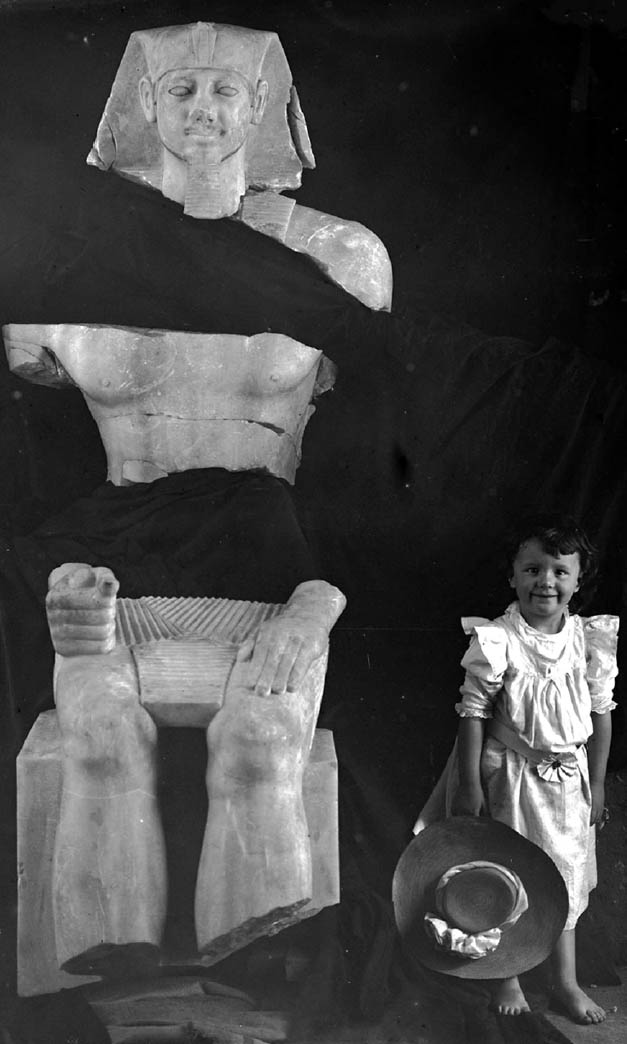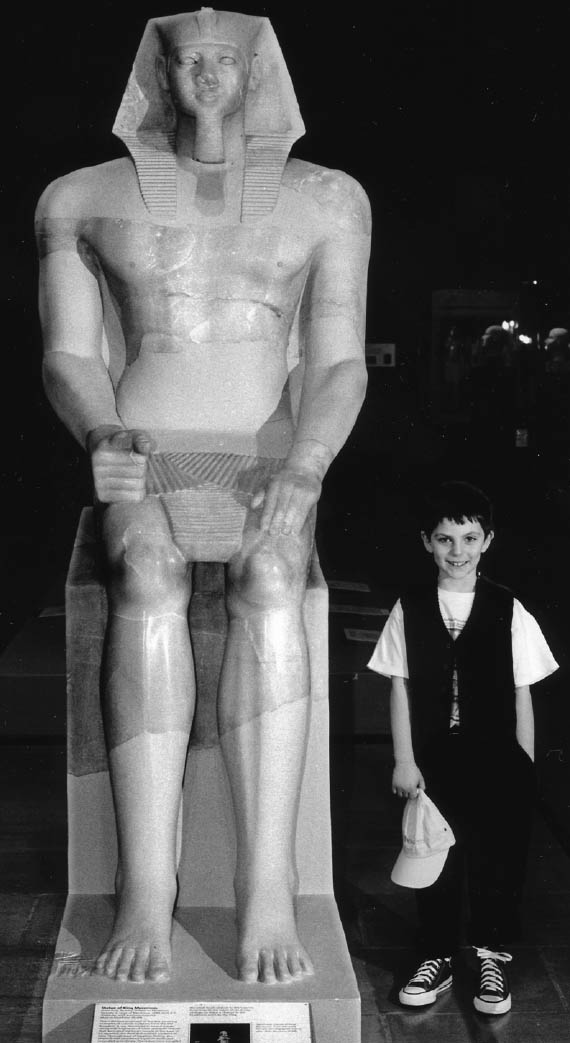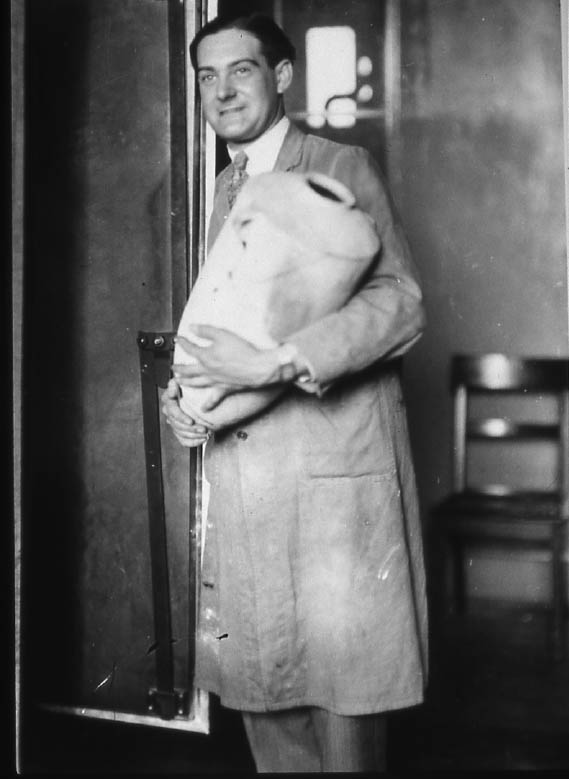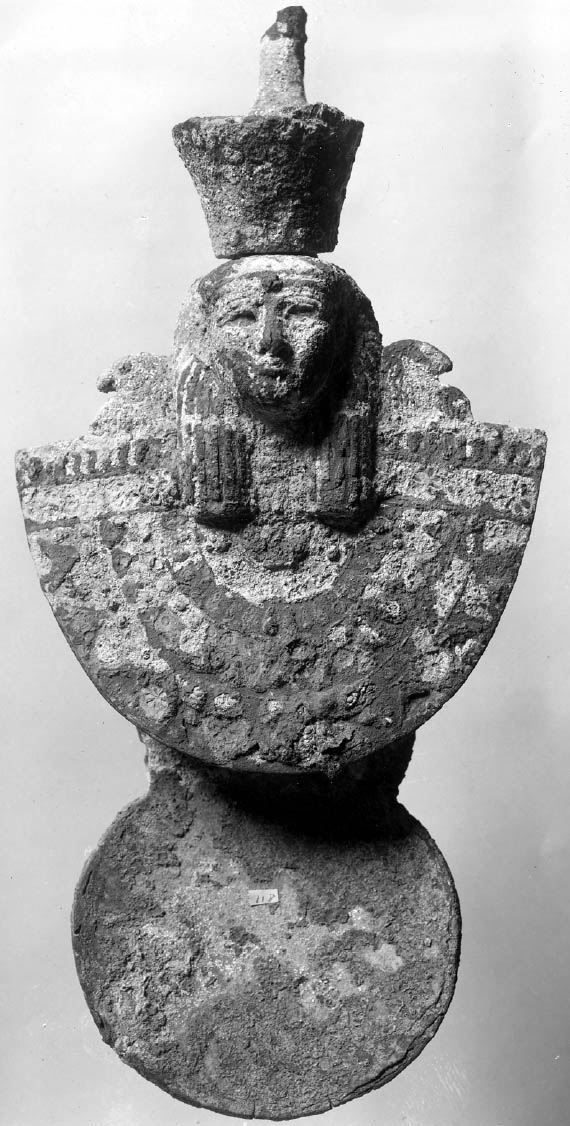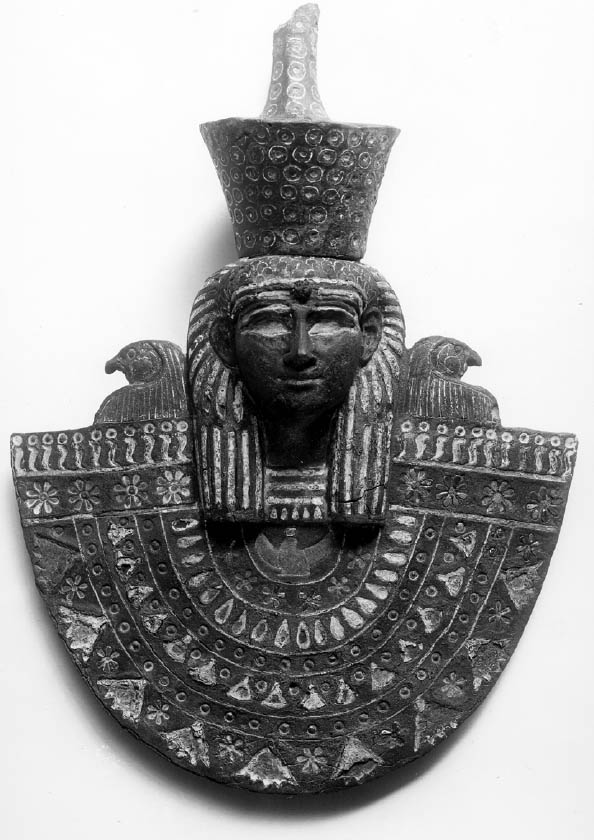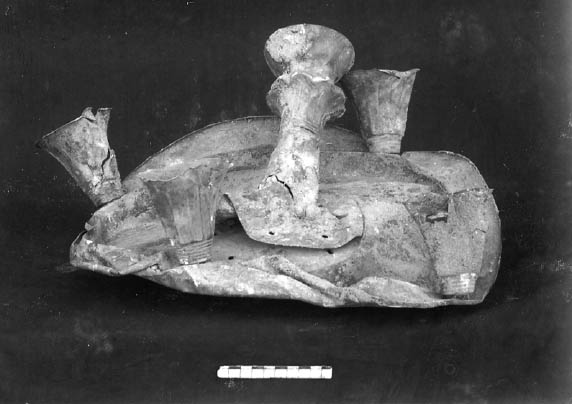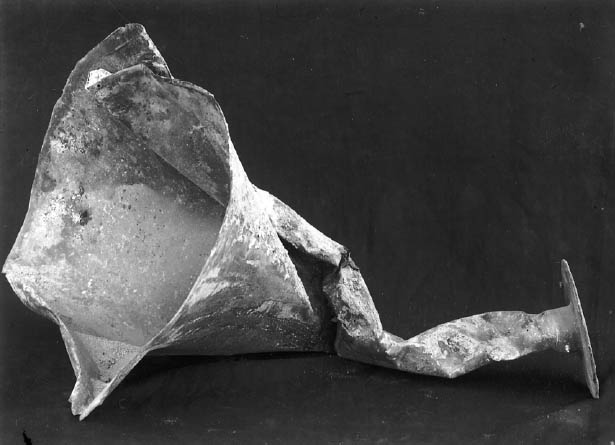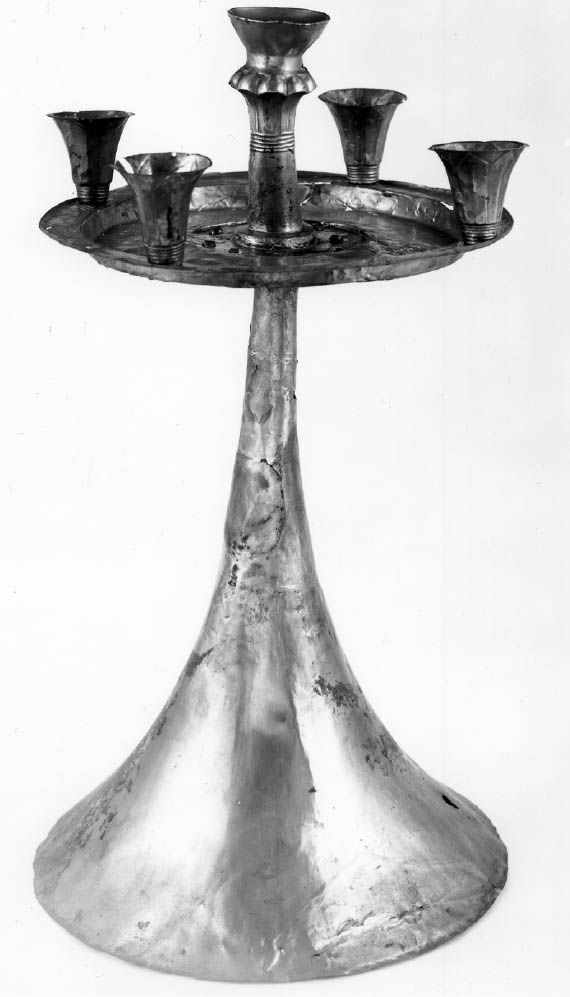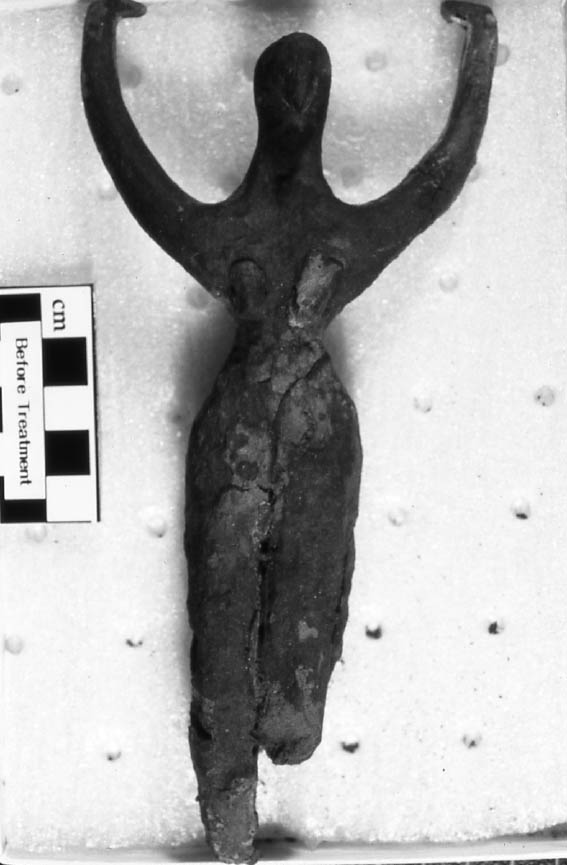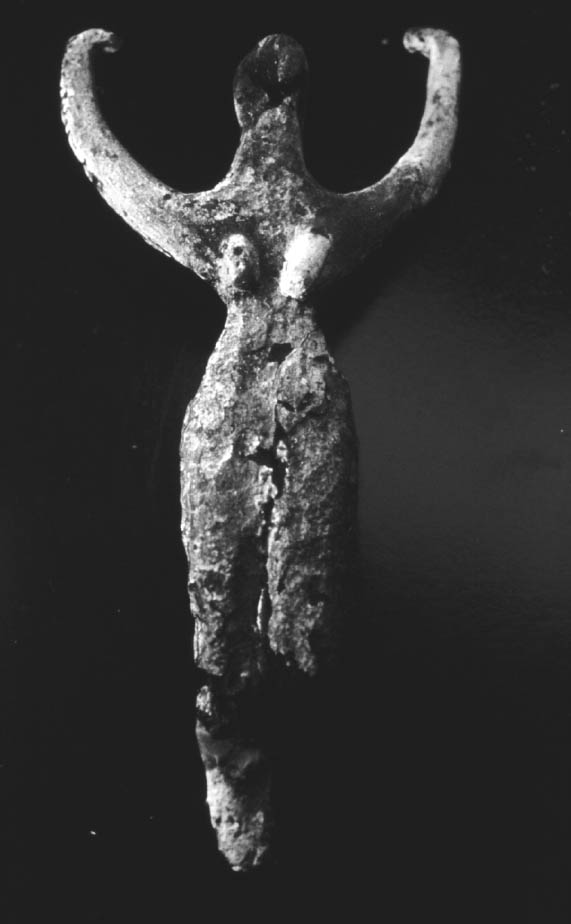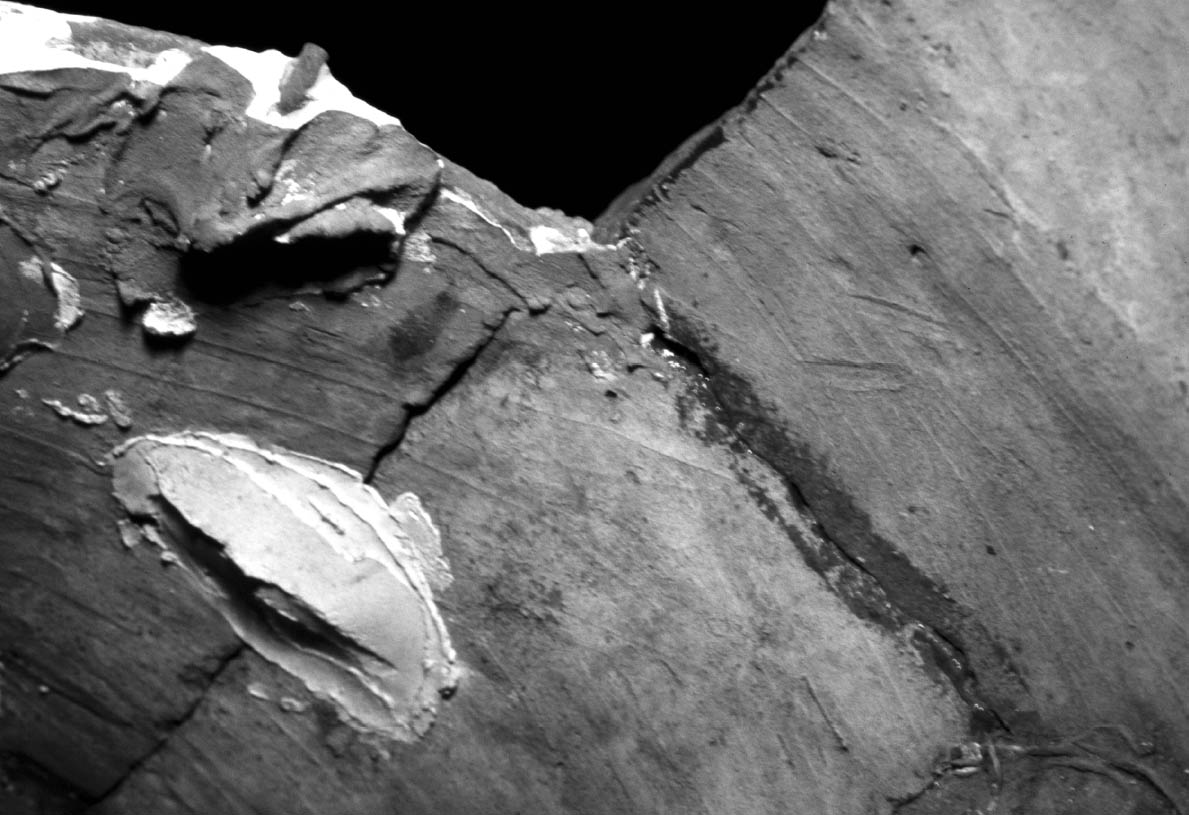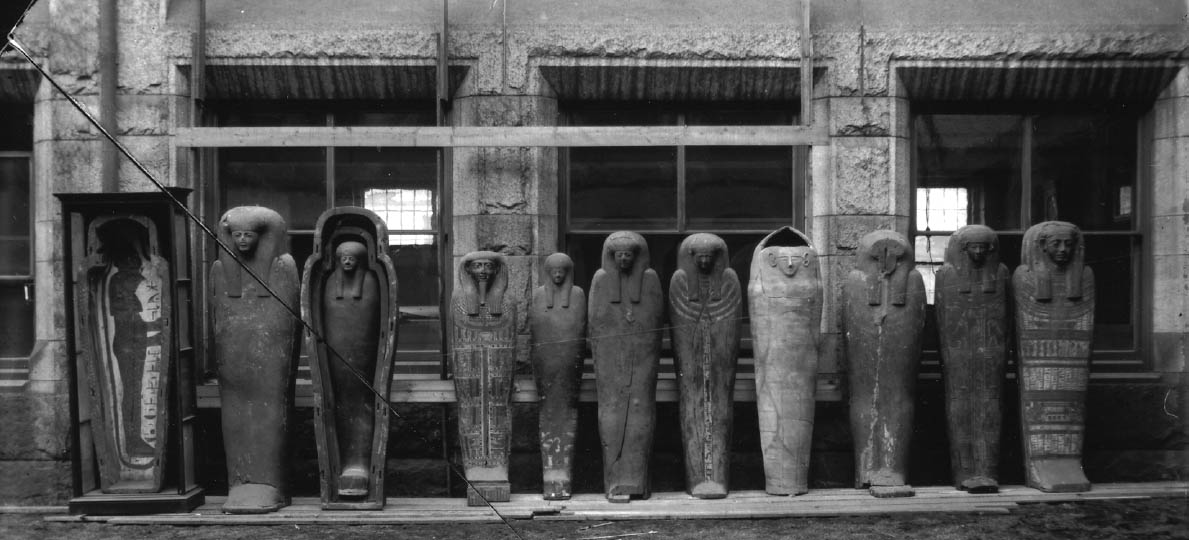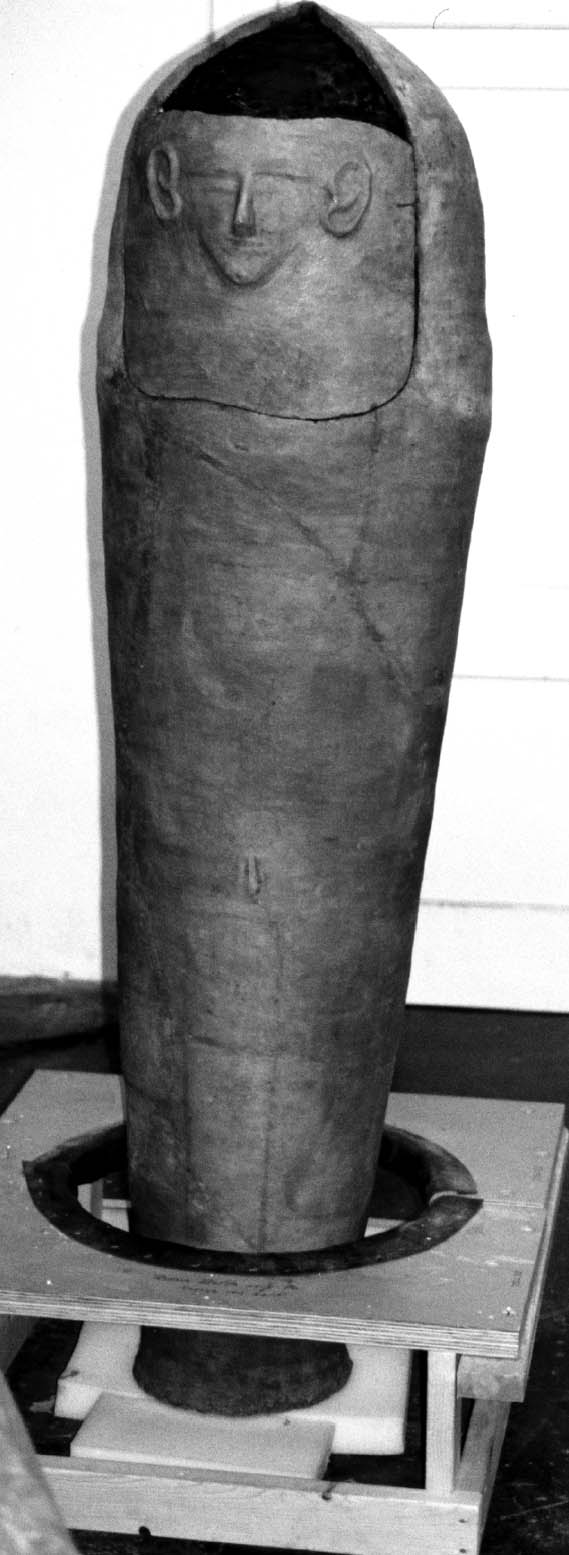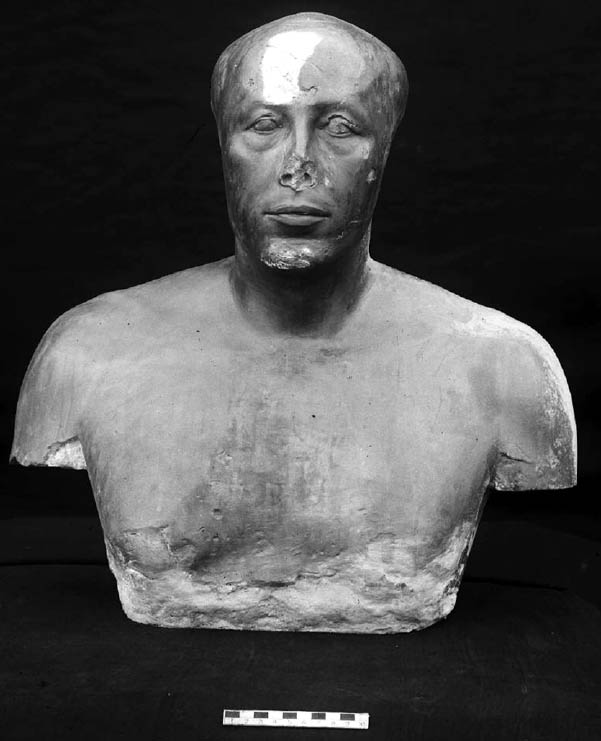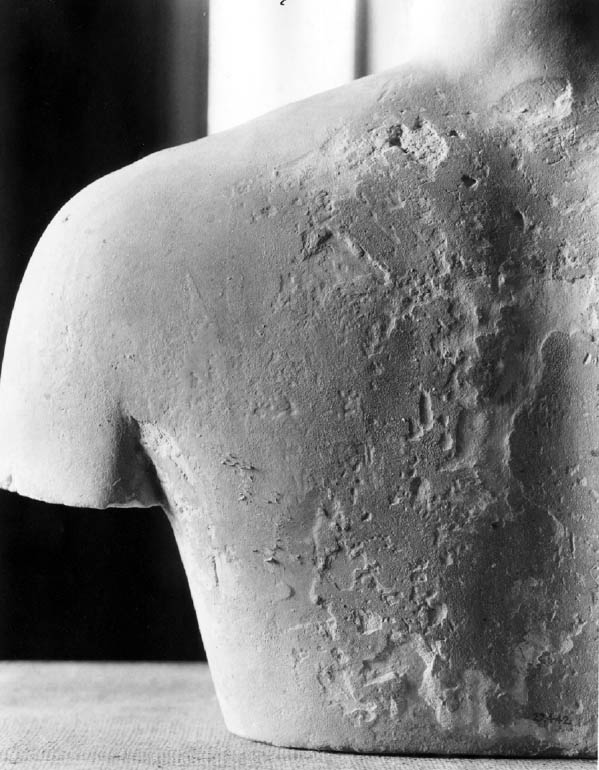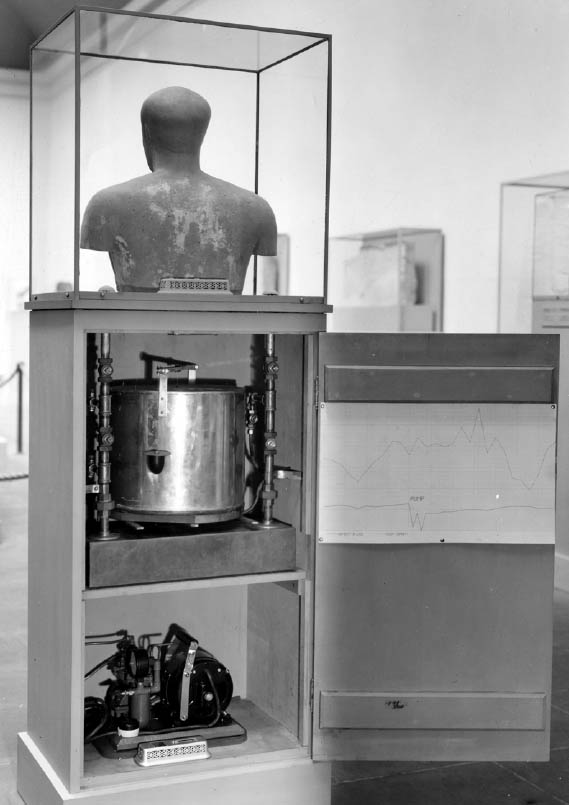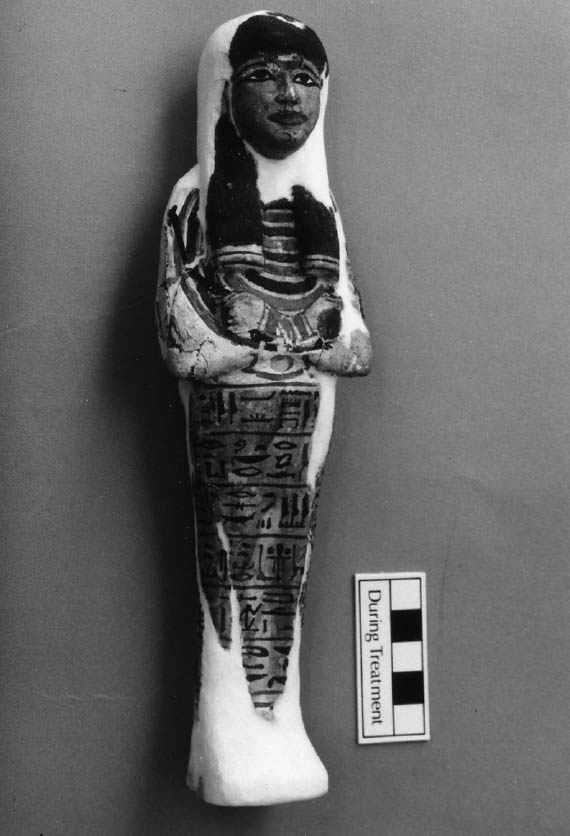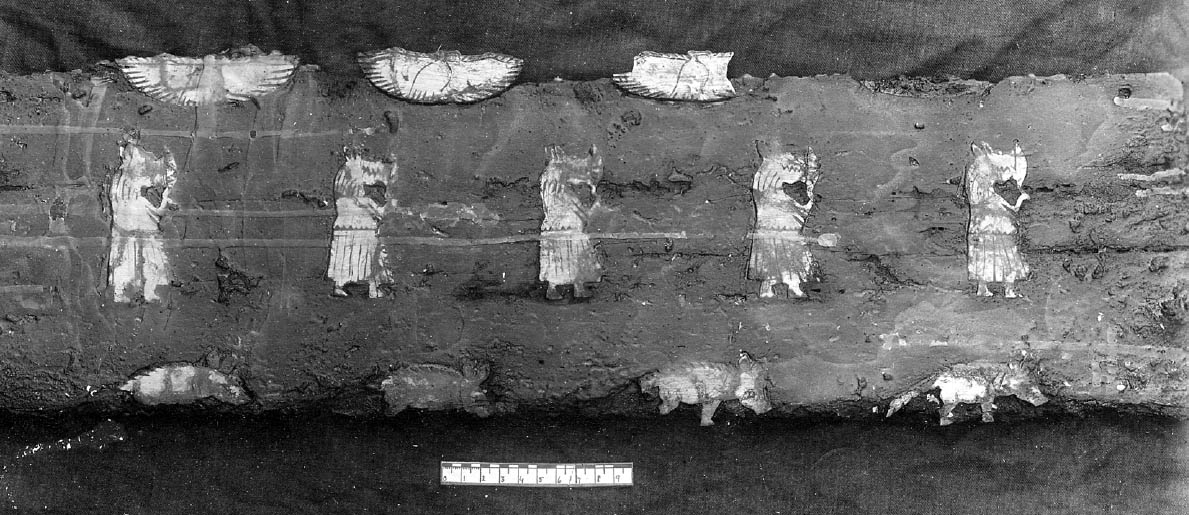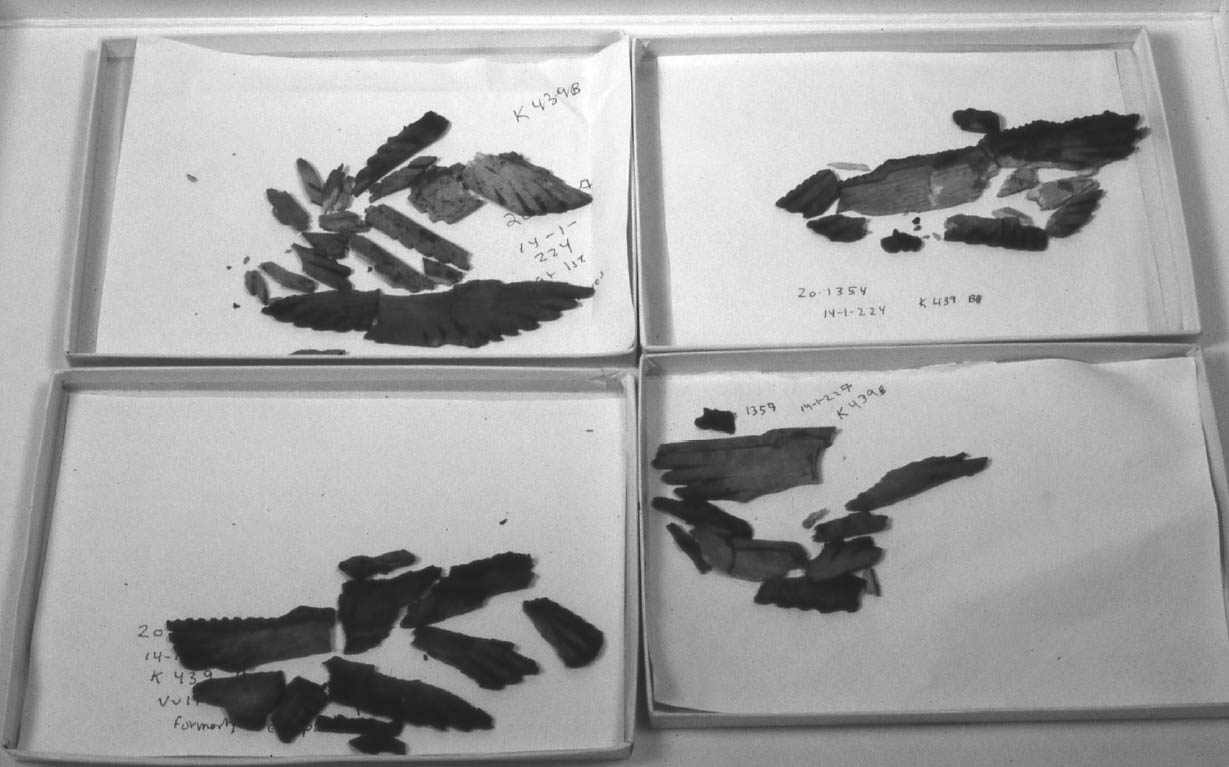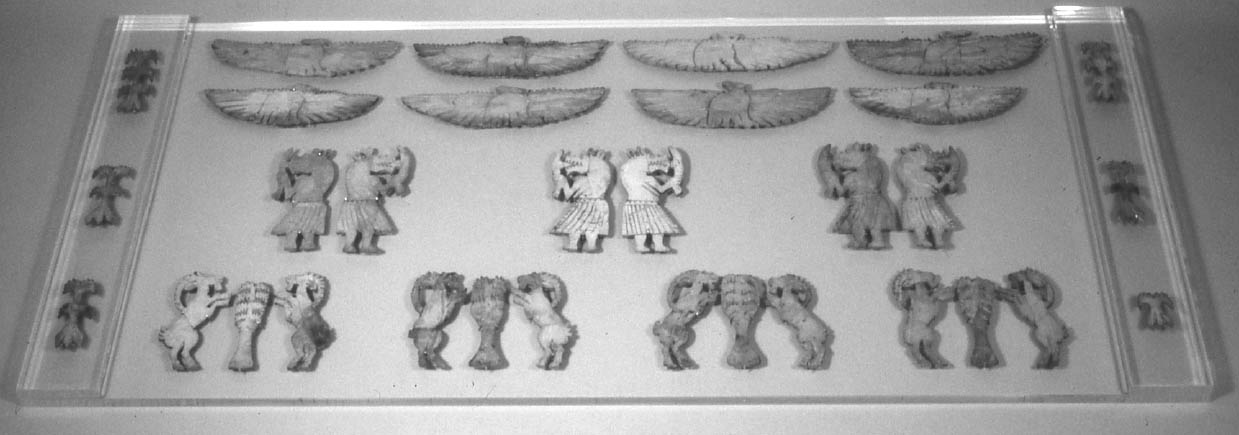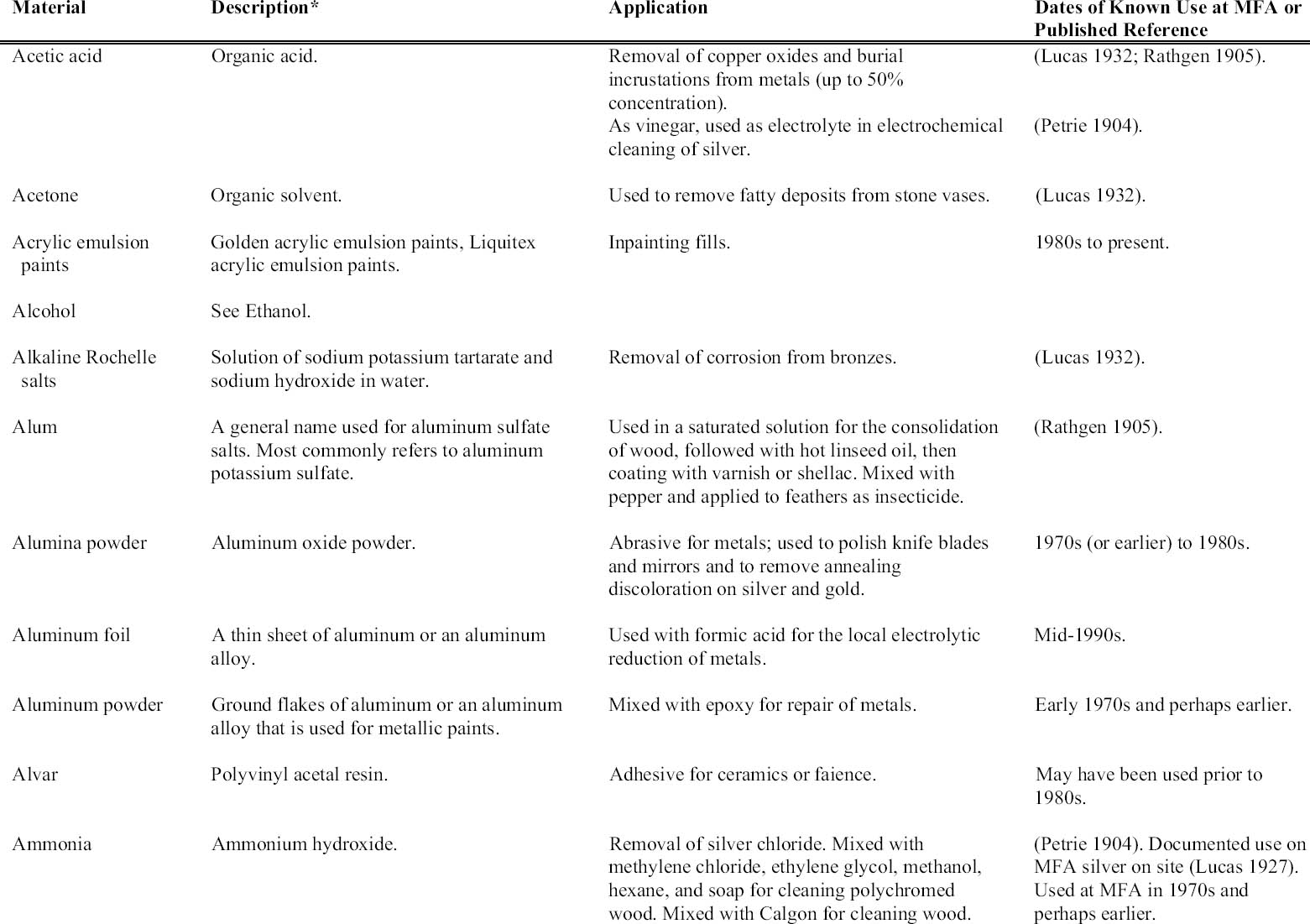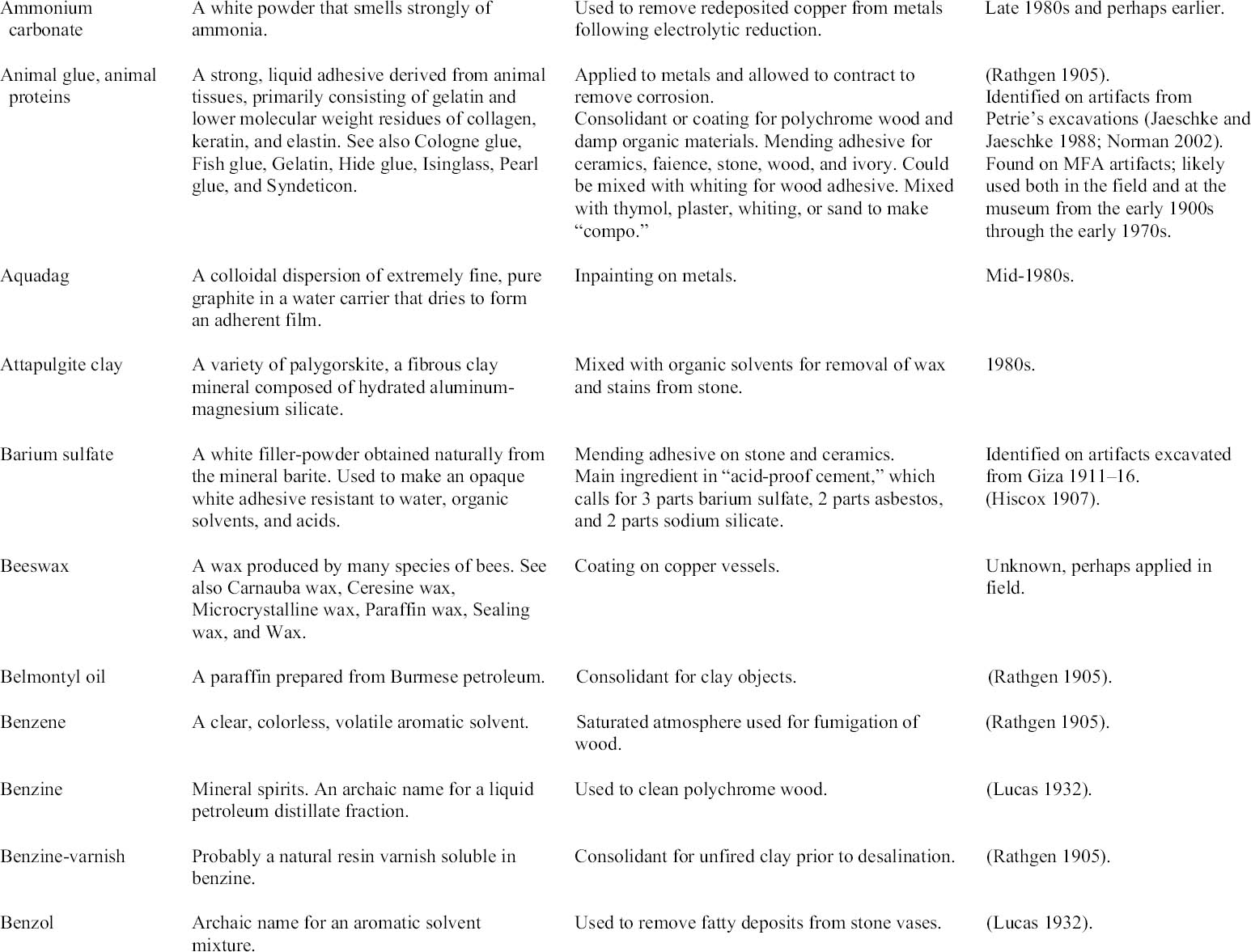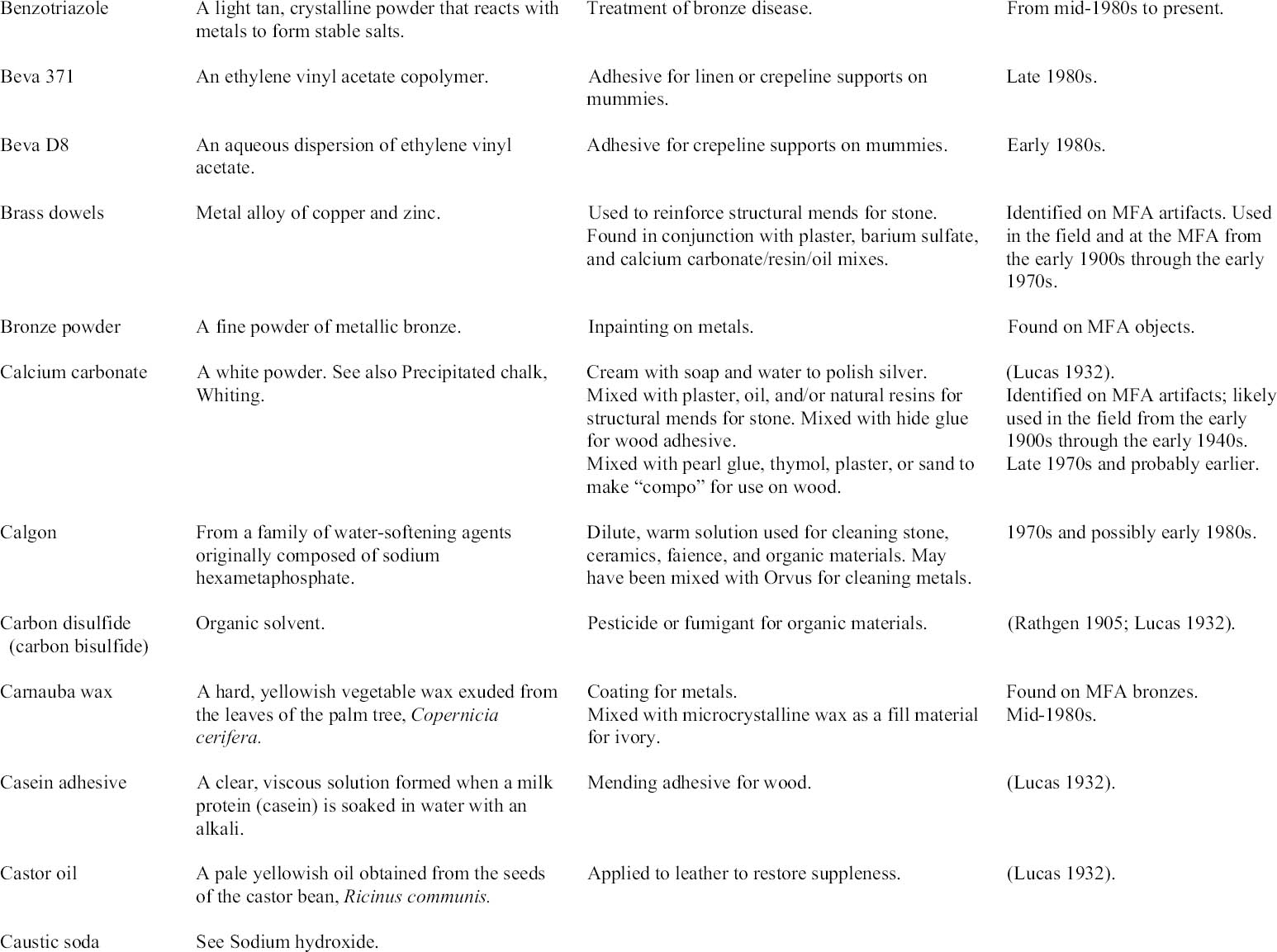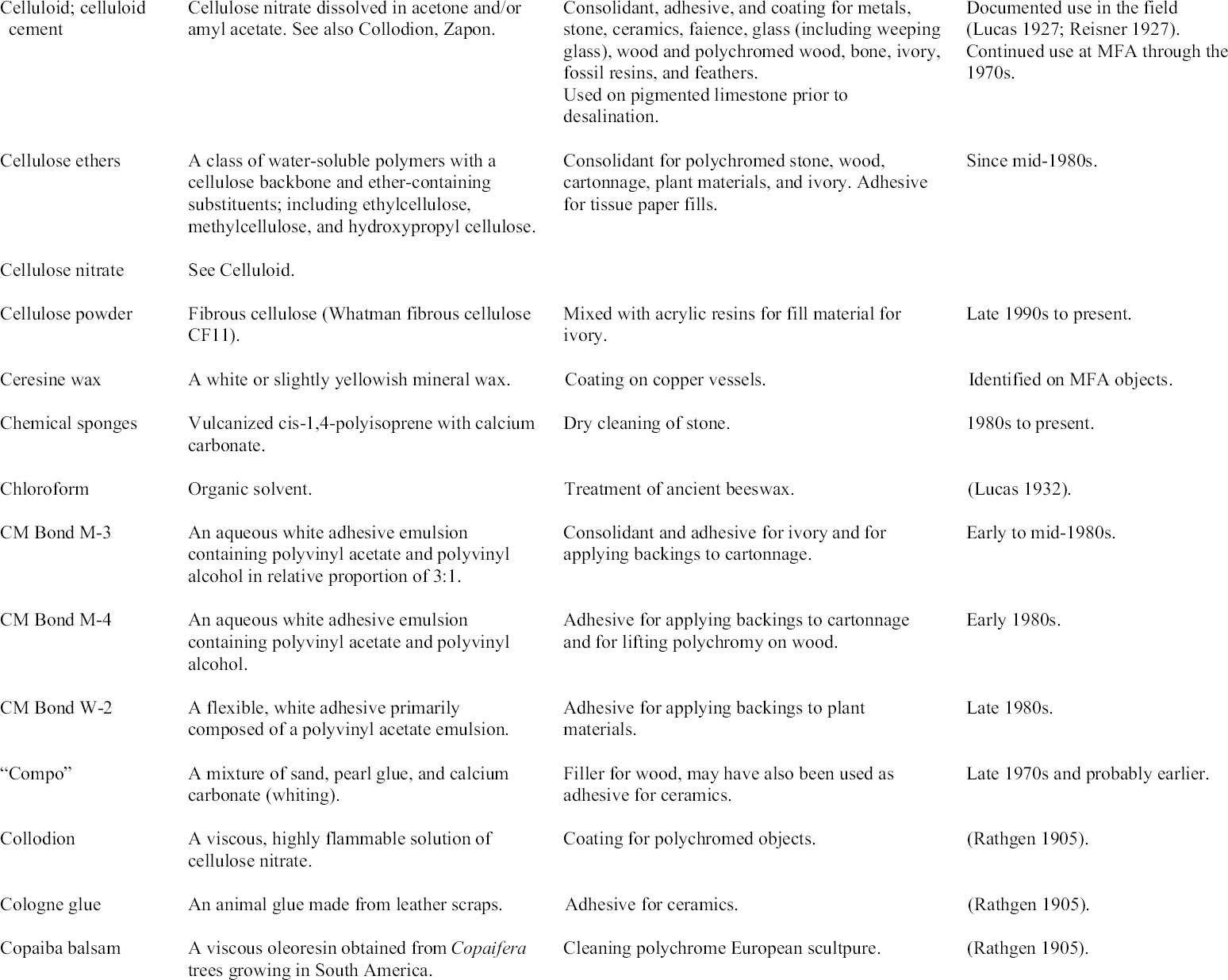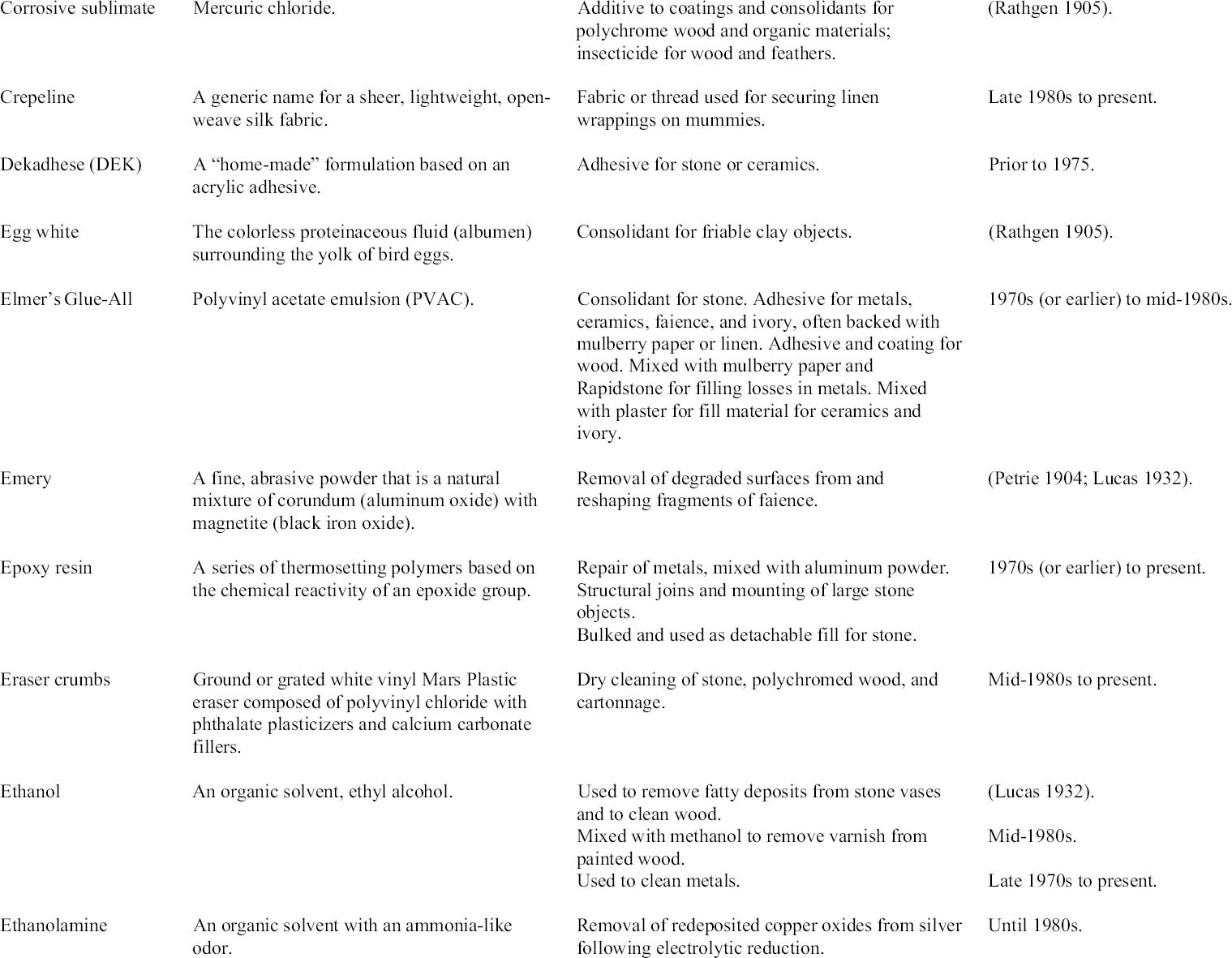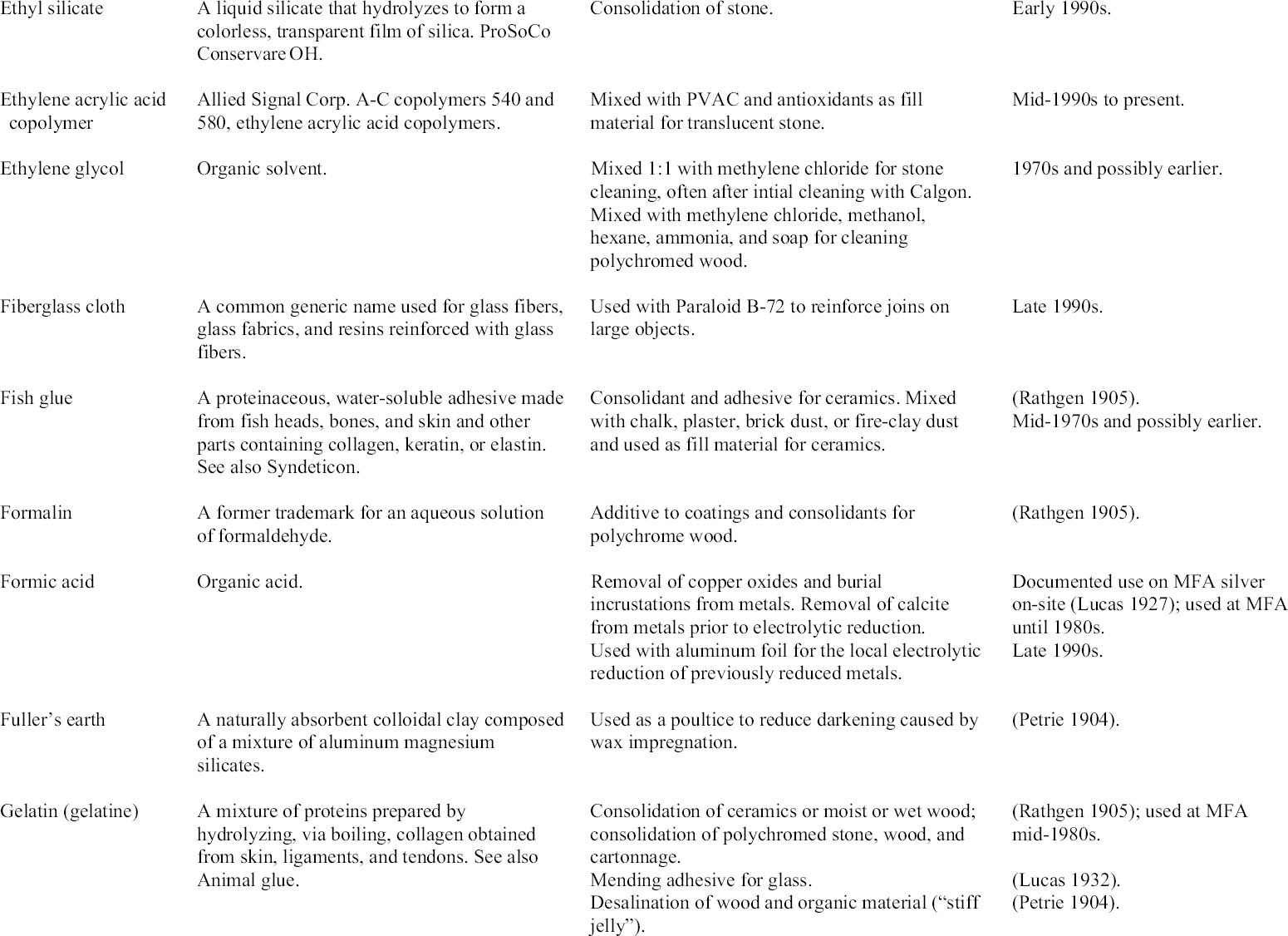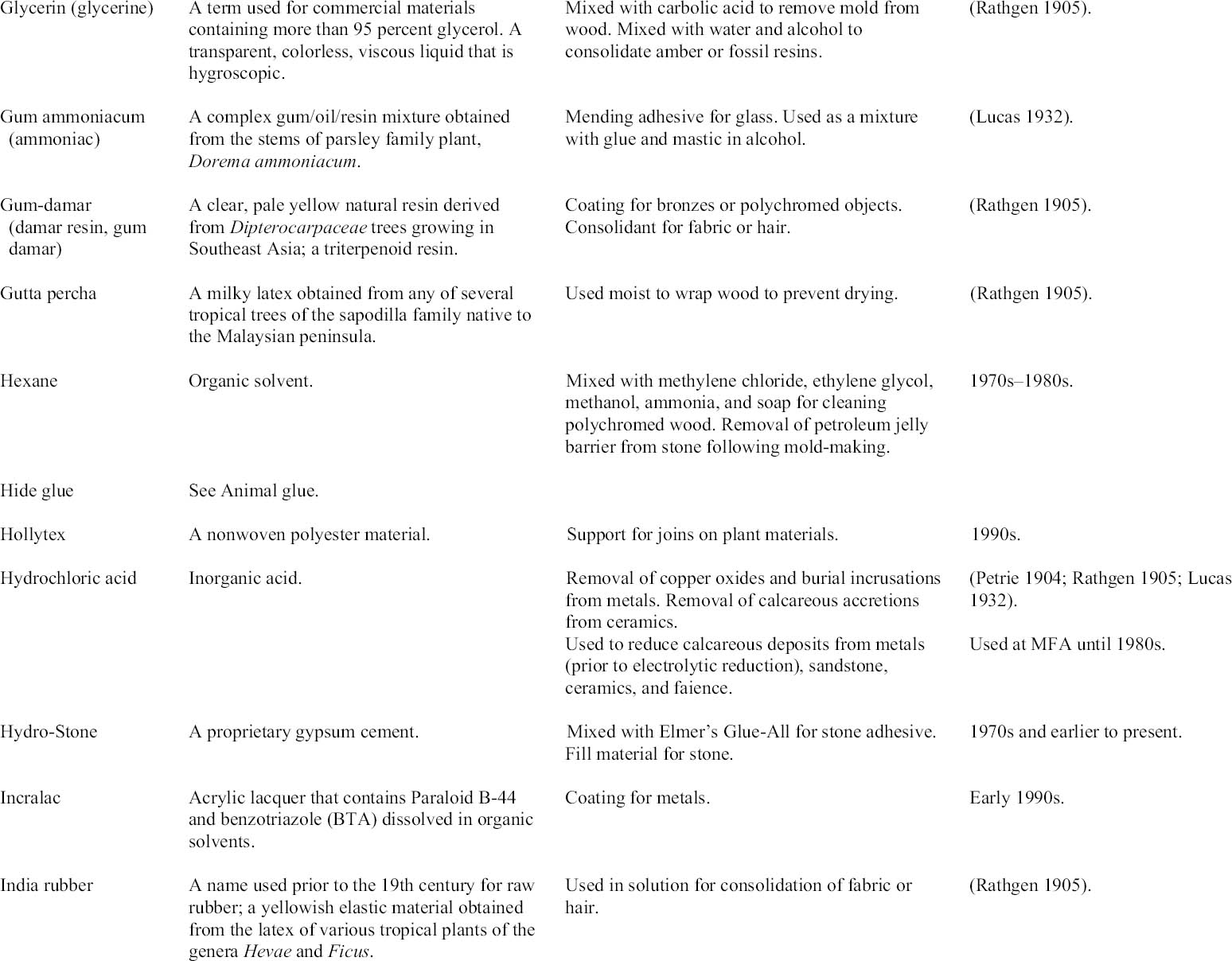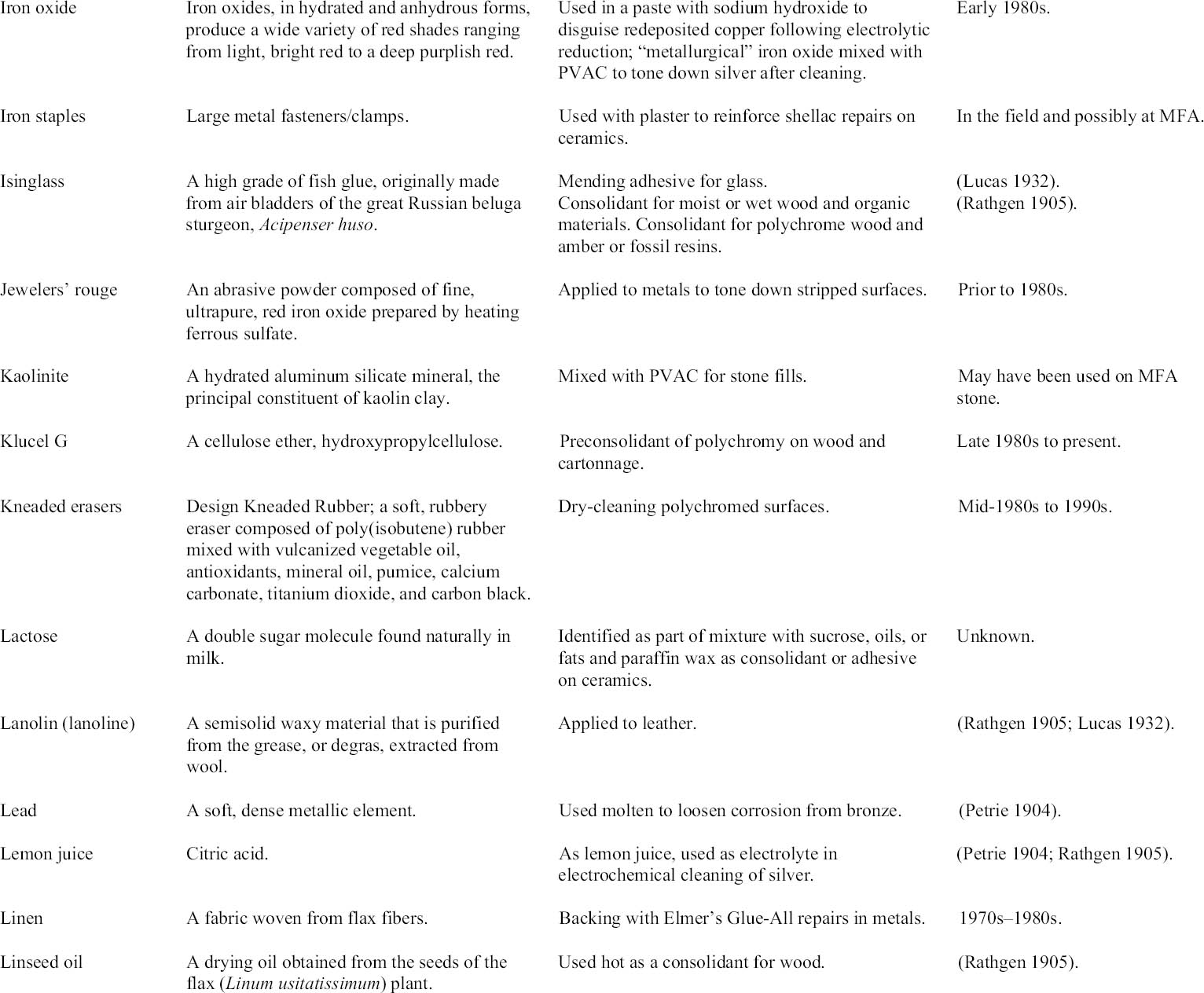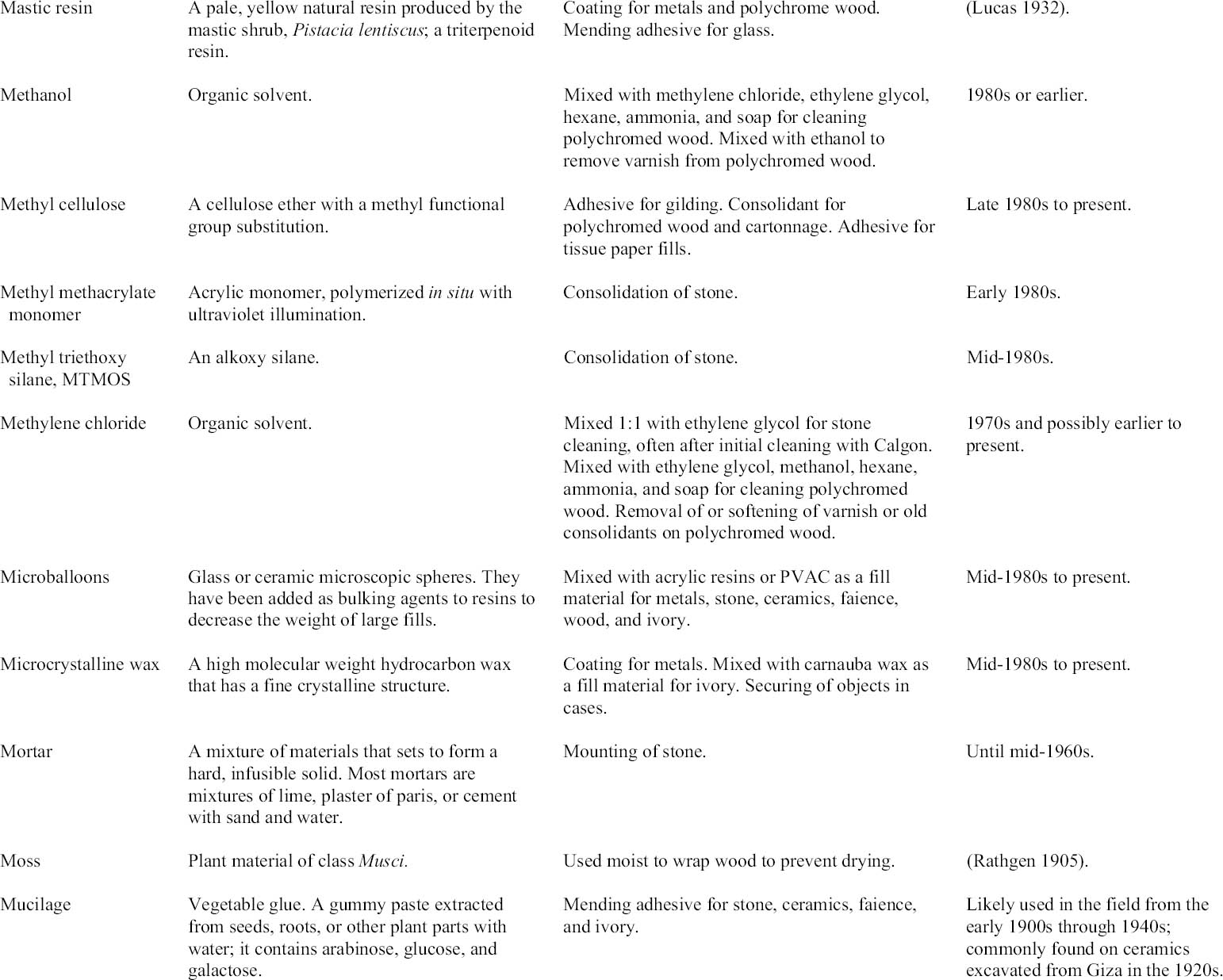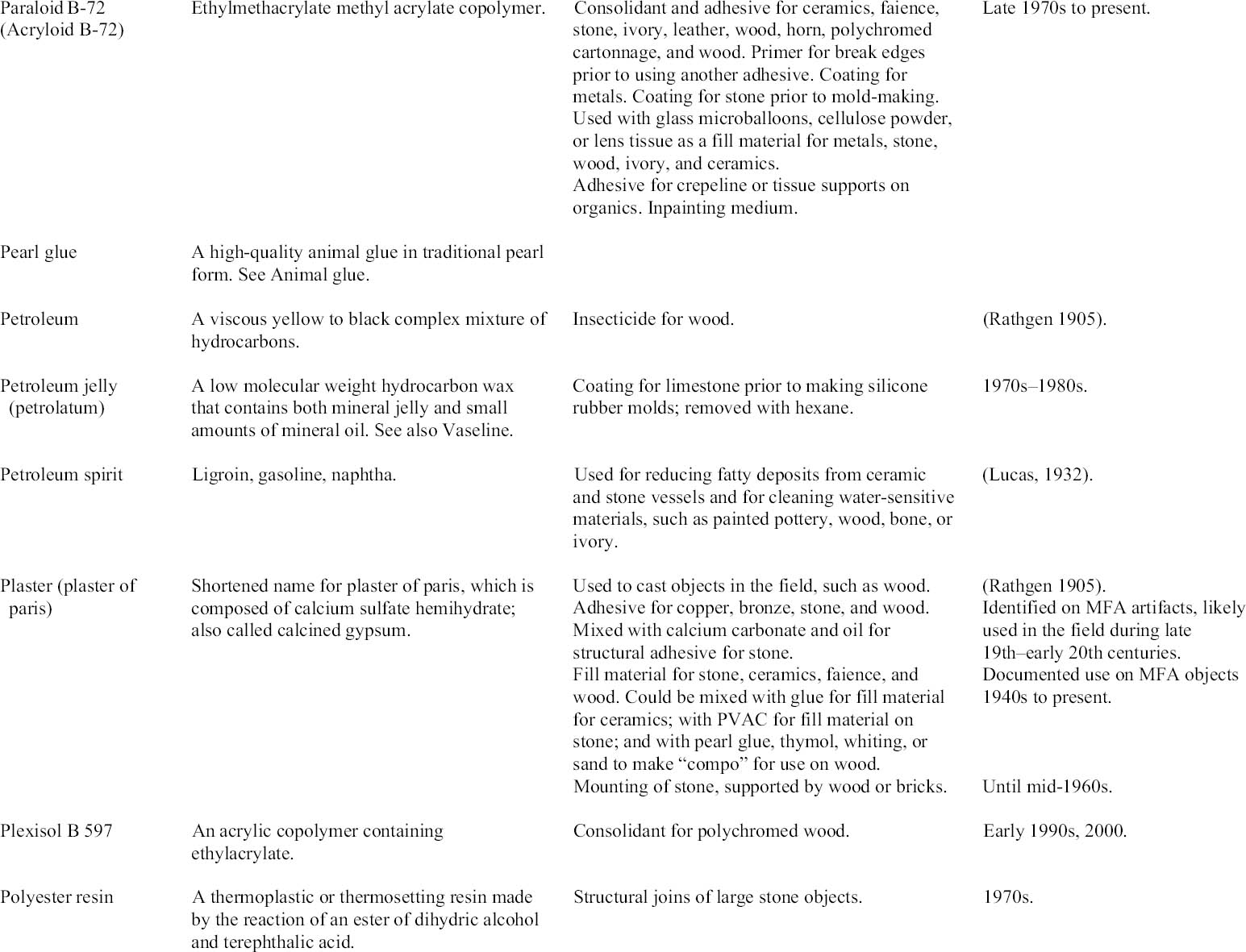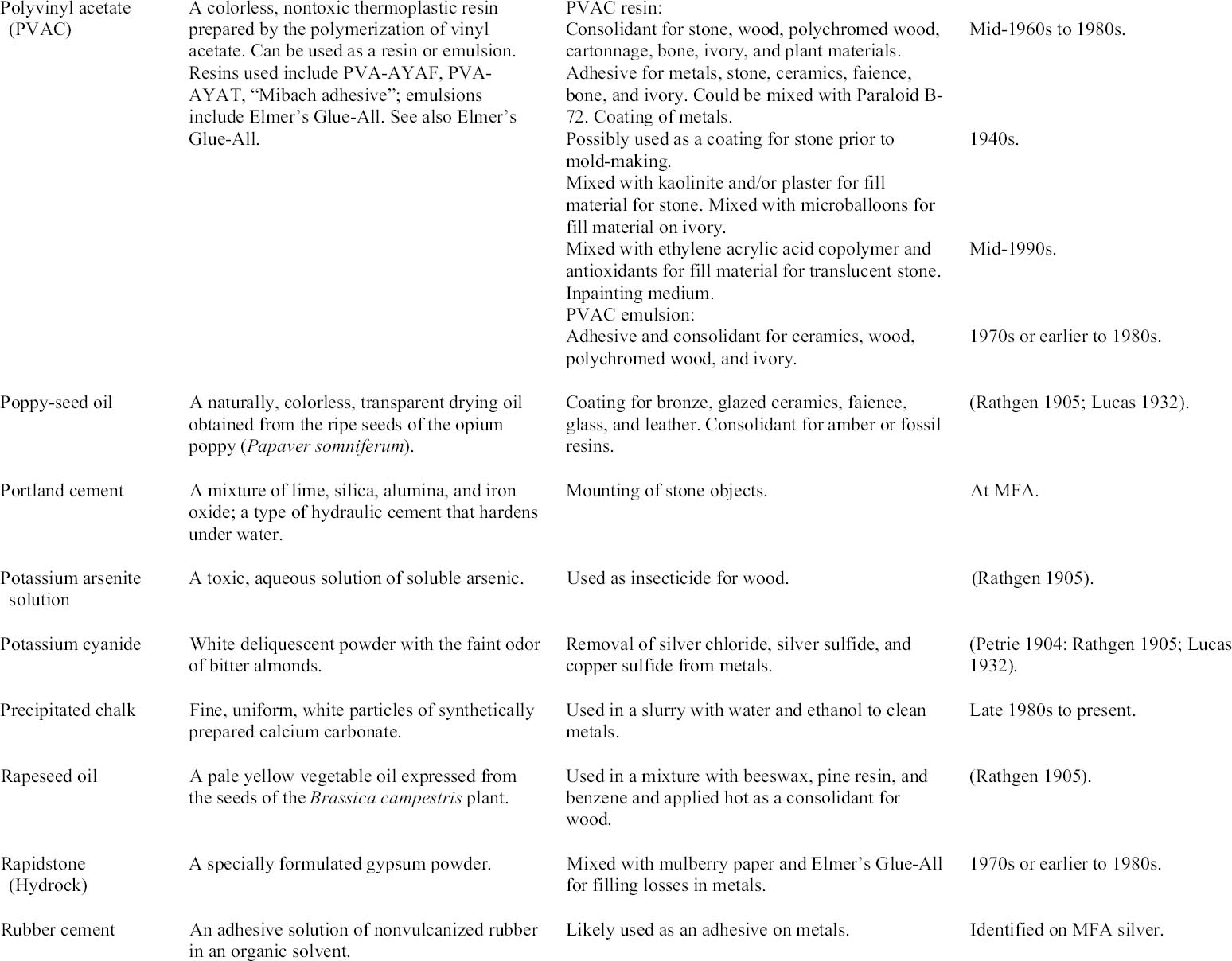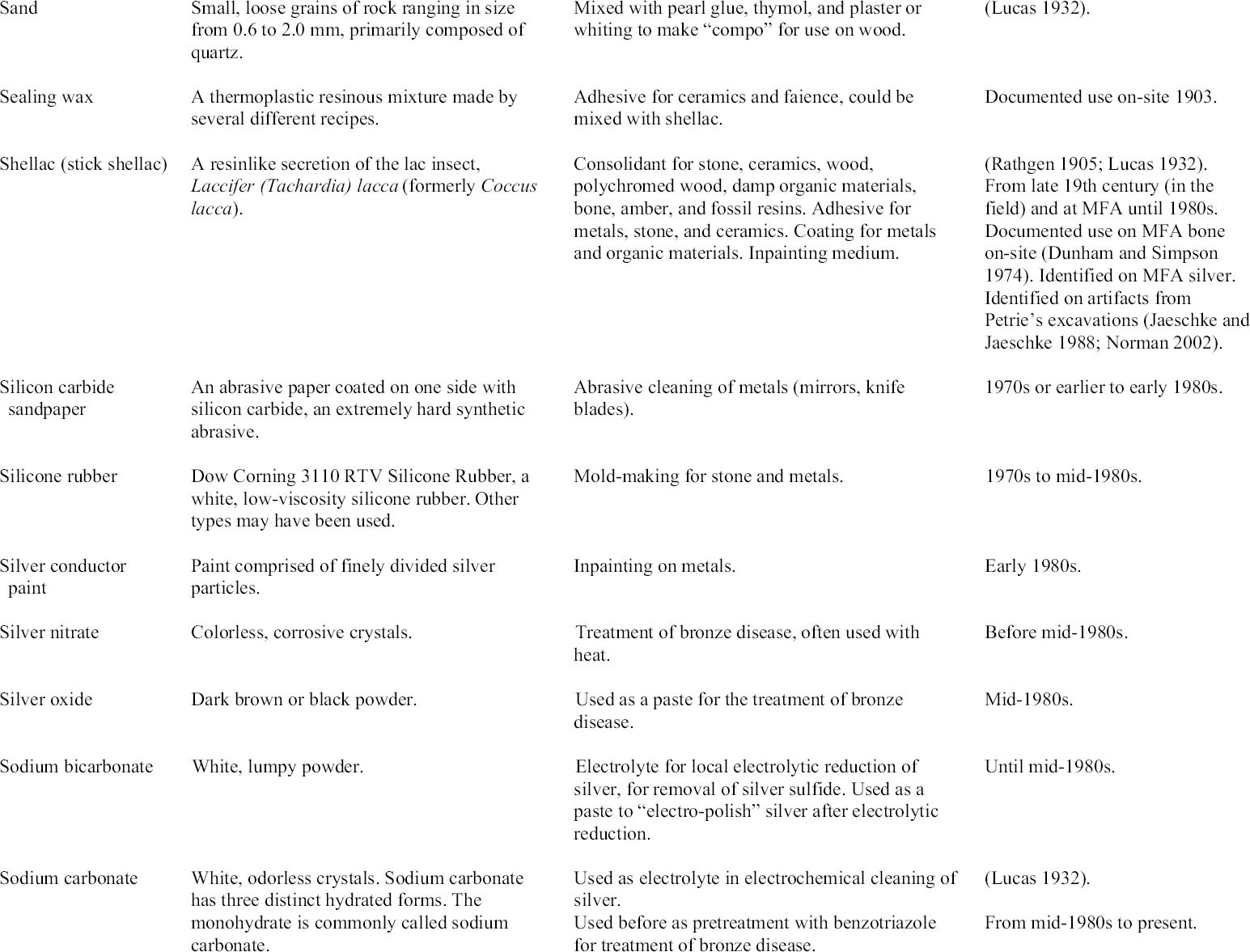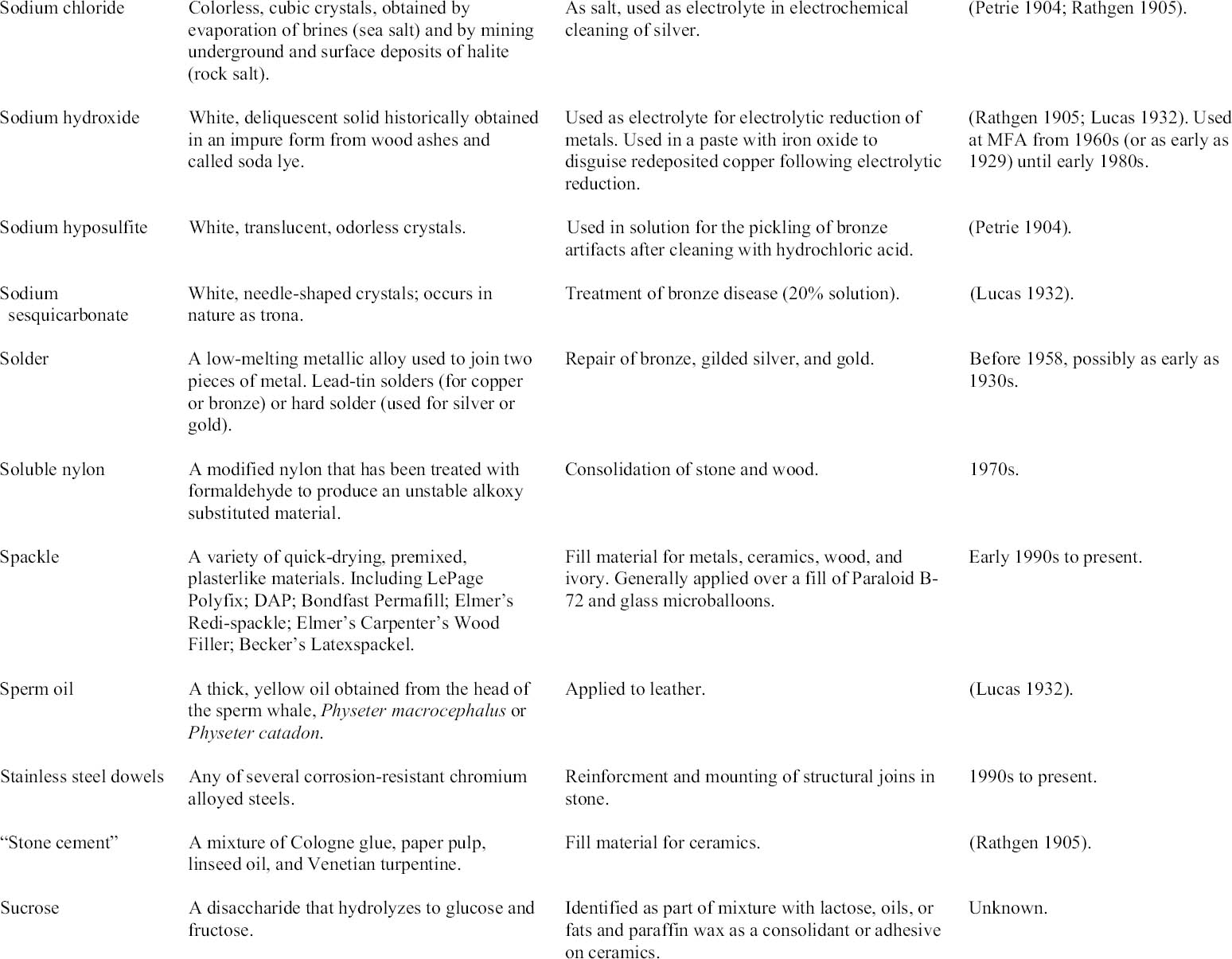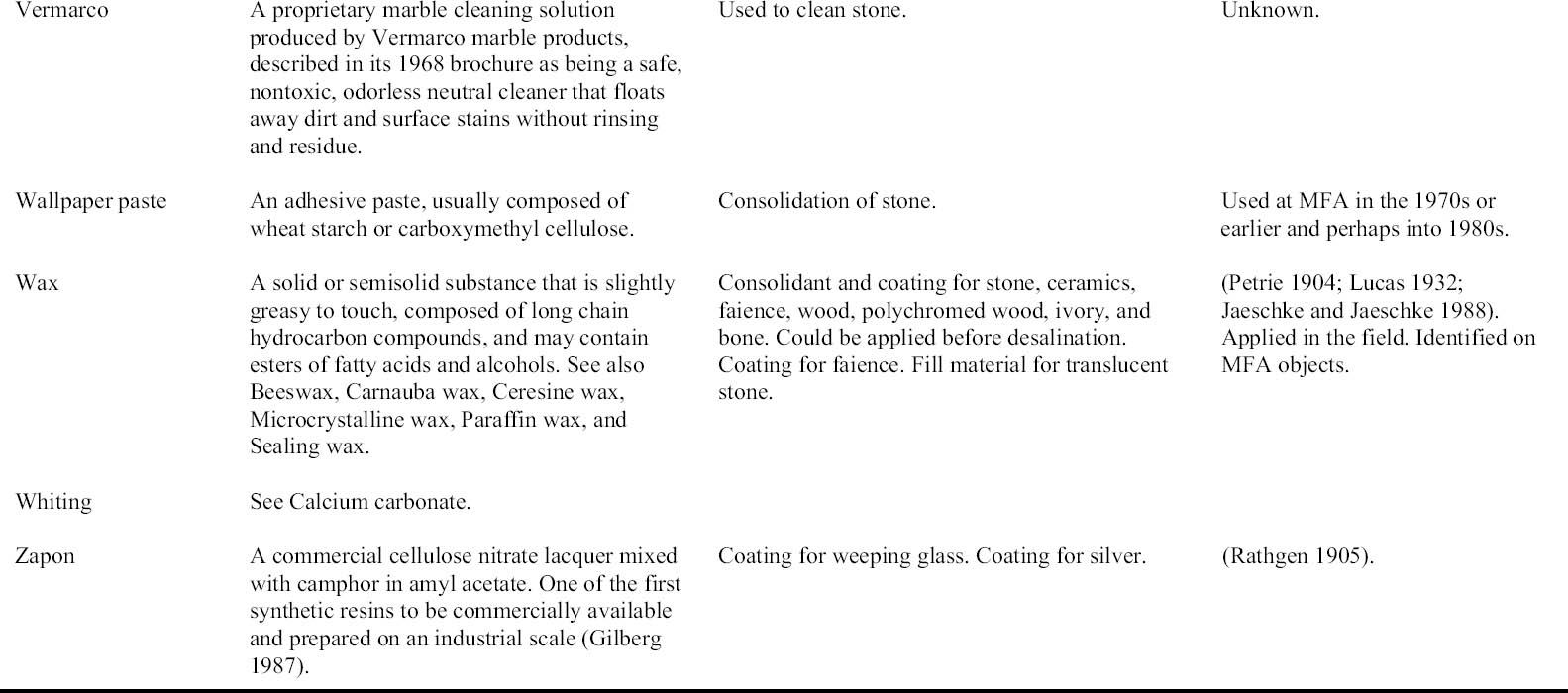THE ANCIENT EGYPTIAN COLLECTION AT THE MUSEUM OF FINE ARTS, BOSTON. PART 2, A REVIEW OF FORMER TREATMENTS AT THE MFA AND THEIR CONSEQUENCESSUSANNE G�NSICKE, PAMELA HATCHFIELD, ABIGAIL HYKIN, MARIE SVOBODA, & C. MEI-AN TSU
ABSTRACT—This article (written in conjunction with Part 1) discusses the conservation of the Egyptian Collection at the Museum of Fine Arts, Boston. The presence of materials used in earlier treatments has had great impact on the nature of current treatments, which often begin with analysis of previously used materials, as their presence can significantly influence the development of a new treatment. The effects of such former treatments on the long-term preservation of the collection are assessed. Sections are divided by material, such as metals, ceramics, stone, wood, and organic materials, and selected examples of re-treatment are discussed. TITRE—La collection d'antiquit�s �gyptiennes au mus�e des beaux-arts (Museum of Fine Arts) de Boston. 2�me partie, une �tude des traitements pratiqu�s ant�rieurement au mus�e et de leurs cons�quences. R�SUM�—Cet article (�crit en m�me temps que le pr�c�dent) consid�re la conservation-restauration de la collection �gyptienne au mus�e des beaux-arts (Museum of Fine Arts) de Boston. Les mat�riaux employ�s lors des traitements ant�rieurs ont eu un impact important sur la nature des traitements actuels. Ceux-ci commencent souvent par l'analyse des mat�riaux pr�c�demment utilis�s, car leur pr�sence peut influencer de mani�re significative le d�veloppement d'un nouveau traitement. Les cons�quences de tels traitements sur la pr�servation � long terme de la collection sont �valu�es. Diverses sections discutent des diff�rents mat�riaux, tel que les m�taux, la c�ramique, la pierre, le bois et les mat�riaux organiques. Quelques exemples sont pr�sent�s d'objets qui furent trait�s de nouveau. TITULO—La colecci�n de arte egipcio antiguo del Museum of Fine Arts, Boston (Museo de bellas artes de Boston). Parte II, Evaluaci�n de los tratamientos previos llezados a cavo en el MFA y sus consecuencias. RESUMEN—En este art�culo (escrito al tiempo con la Parte I) se discute la conservaci�n de la colecci�n de arte egipcio del Museum of Fine Arts, Boston—MFA (Museo de bellas artes de Boston). La presencia de materiales usados en tratamientos anteriores ha tenido un gran impacto sobre la naturaleza de los tratamientos actuales, que frecuentemente comienzan con el an�lisis de estos materiales utilizados previamente ya que pueden tener un gran impacto en el desarrollo del nuevo tratamiento. Se eval�a el efecto a largo plazo que estos tratamientos previos pueden tener sobre la preservaci�n de las colecciones. Las secciones se dividen de acuerdo a los materiales: metales, cer�mica, piedra, madera, materiales org�nicos. Tambi�n se analizan algunos ejemplos selectos de tratamientos hechos de nuevo. TITULO—A cole��o de antig�idades eg�pcias do Museum of Fine Arts—MFA (Museu de Belas Artes) de Boston. Parte 2, revis�o de tratamentos pr�vios no MFA e suas conseq��ncias. RESUMO—O artigo (continua��o da parte 1) discute a conserva��o da cole��o eg�pcia do Museum of Fine Arts (Museu de Belas Artes) de Boston. O uso de certos materiais em tratamentos anteriores teve um grande impacto na escolha dos tratamentos atuais, que freq�entemente come�am com an�lise de materiais previamente usados, uma vez que sua presen�a pode influenciar significativamente o desenvolvimento de um novo tratamento. Os efeitos destes tratamentos anteriores na preserva��o da cole��o a longo prazo s�o avaliados neste artigo. As sess�es s�o divididas por tipo de material, tais como: metal, cer�mica, pedra, madeira e materiais org�nicos. S�o apresentados exemplos selecionados de objetos tratados novamente. 1 INTRODUCTIONOver the past decades, the demand to display objects of the Egyptian Collection of the Museum of Fine Arts, Boston (MFA), has dramatically increased, with many national and international loans, some of long-term nature. Exhibitions and loans have provided the opportunity to study, treat, re-treat, and mount large groups of objects. Numerous artifacts received emergency stabilization upon excavation in the field (see Part 1, G�nsicke et al. 2003). Subsequent phases of 2 EARLY HISTORY OF CONSERVATION AT THE MFA: THE RESEARCH LABORATORYMany of the excavated Egyptian artifacts needed major treatment and restoration prior to exhibition at the MFA. Alfred Lucas consulted on the stabilization of artifacts through written correspondence with Dows Dunham, curator of the Egyptian Department from 1942 to 1957. Museum documents suggest that Dunham carried out many treatment procedures himself, such as the desalination of ceramics (Dunham 1928). Joseph Linden Smith, an honorary curator of the Egyptian Department and a distinguished painter who documented tomb reliefs in Giza with life-size oil paintings, was called upon to assist in large-scale restorations such as that of the colossal statue of Menkaure (Mycerinus) (MFA 09.204; Reisner 1931). The restoration, which entailed re-creating missing passages based on a related sculpture in Cairo, was completed in 1935 by Smith with the help of a graduate of the Museum School, an art school associated with the MFA (Dunham 1935). The statue currently stands in the Old Kingdom Gallery, its condition virtually unchanged since the time of the 1935 restoration (figs. 1, 2). In 1929, the British chemist William (Bill) Young was invited to Boston by MFA trustee E. P. Warren (fig. 3). Young's successful treatment of a heavily corroded bronze Aegis (fig. 4; MFA 31.195; Dunham 1931) convinced the Board of Trustees that the MFA needed a department devoted to treatment of its collections (Schur 1977). Thus the Department of Restoration, later renamed the Research Laboratory, was formally established. Trained by his father at the Ashmolean Museum Laboratory, and associated with the Pitt Rivers Museum and the Institute for Archaeological Research in London, Young pioneered many procedures associated with the scientific examination and treatment of works of art and organized a series of international symposia titled, “Application of Science in the Examination of Works of Art,” the first taking place in 1958. Dated documentation related to treatments or examinations began in 1940, although there are 205 earlier, undated records. Young's records generally state the reason for an object's being in the laboratory, such as “Ascertain whether the objects are copper or bronze” or “Determine authenticity,” and the procedure followed, such as “microscopic, spectrographic or visual.” The report may state: “the object is copper,” or “a forgery,” or “condition determined.” These records are useful in letting us know that an object was in the laboratory, and they often indicate the type of analysis. Unfortunately, they do not describe the condition or treatment of objects. More specific information on selected objects can be gleaned from publications, such as the Bulletin of the Museum of Fine Arts (MFA Bulletin), which was published beginning in 1903. In 1968, the Murray Pease Report established guidelines for practice and a code of ethics for conservation that emphasized the importance of documentation (IIC-AG 1968). An outcome of this development may have been the system of work-sheets introduced in 1971, which are apparently the earliest treatment reports. Some reports may be as cursory as “Standard Operating Procedure” or “SOP,” but occasionally there is more specific information regarding the condition and treatment. Condition reports, treatment proposals, and treatment reports, as we use them today, came into use about 1981. Merville E. Nichols, a prot�g� of Young, treated large parts of the collection over decades. He started his training with Young in 1947 and was associated From discussions with MFA staff who remember early conservation materials and procedures (Beale 2002; Lachevre 2002), it is believed that many materials were introduced to the museum by Young and then adopted by Nichols and the conservators who worked with them.
3 PAST TREATMENTS AND INFLUENCES ON CURRENT CONDITIONSWhen an object is examined today to assess its condition and develop a treatment, often there is evidence of former stabilization(s) or compensation(s). Treatments frequently must address aged, unstable adhesives, incomplete or unsuitable consolidation, or
4 METALS4.1 CLEANING AND REDUCTIONThe history of the treatment of Egyptian metal objects at the MFA is tied to electrolytic reduction. Many objects in the collection have been cleaned by such a procedure. The condition of objects cleaned in this fashion is often described in later treatment reports as being metallic, granular, pitted, etched and/or scratched, or smooth and without corrosion products. In some cases it is noted that uneven corrosion products remain. Of the 139 object files for copper and bronze objects reviewed for this article, only 12 pieces were noted to retain original corrosion products, burial accretions, or pseudomorphs.
One of the earliest treatments, published in the MFA Bulletin in 1931, is that of the 22d Dynasty
The MFA Bulletin article described the materials and the method of fabrication, but did not elaborate on the treatment. It was noted that a gilded silver inlay of a winged figure “was found so badly oxidized that it could not be preserved” (Dunham 1931, 109), and indeed this inlay is missing today. The treatment record for the object states simply: “The object was cleaned by electrolysis.” Young later presented his treatment of the Aegis in lectures and articles where, citing the work of earlier chemists Adolf Finkener, Friedrich Rathgen, and Colin Fink, he described the reduction of ancient metals. The procedure was as follows:
Young also mentioned the use of iron, nickel, and platinum anodes. When the reduction was completed, the object was “removed from the bath, soaked in several changes of hot water to remove all traces of caustic soda, followed by drying in an oven at 40 to 60 degrees centigrade” (Young 1963, 6). This method was passed on to Nichols. Electrolytic reduction continued to be used for the treatment of copper and its alloys, silver, gilded silver, electrum, lead, and iron until the early 1980s. For the reduction of silver, Nichols's notes and instructions expand upon the basic method outlined above. Before reduction was undertaken, an object might be examined with x-radiography, ultraviolet illumination, or metallographic sections to determine the presence of core metal and check for ancient or modern restorations. The object would undergo prolonged soaking in a series of solvents (toluene, hot water, alcohol, and acetone), and coatings, restoration materials, and any material from burial that would interfere with conductivity were mechanically removed. Lead-tin or zinc-tin solder repairs were removed with a soldering iron. The object was then soaked in a bath of 2% sodium hydroxide to remove remnants of organic matter and to raise the pH of the silver (Nichols noted that this bath will also dissolve silver chloride and cautioned that the object may turn to mud if totally corroded). Finally, various mixtures of hydrochloric and formic acids were used to remove calcite accretions and to increase the For tank reduction, fragile objects might be supported on a bronze screen. For local reduction of silver, the cathode was a graphite rod. The anode was a sponge pierced with a graphite rod and immersed in the electrolyte. Two anode sponges would be used, one containing sodium bicarbonate (to remove silver sulfide), the other containing 2% sodium hydroxide (to remove silver chloride and to “harden” the corrosion material for removal with a scalpel). After these steps were repeated, the current was reversed to oxidize the silver, turning it black, at which point the black surface would be cleaned with ethanolamine on cotton swabs to remove redeposited copper oxides, carbon, and grease. The procedure was repeated several times, along with brushing under hot running water and the use of a scalpel. Finally, the piece was “electro-polished” using sodium bicarbonate paste and soaked in distilled water until the pH was neutralized (Nichols n.d.). Object files mention removal of redeposited copper with ethanolamine, as mentioned above. Redeposited copper was also disguised by bronzing with sodium hydroxide paste and iron oxide or removed using ammonium carbonate and wooden tools. One of the primary reasons for the early stripping of bronzes was to rid them of chloride that causes bronze disease (Beale 1996). MFA records also state the following goals: to remove corrosion, to allow reshaping and reforming, and to reveal inscriptions. By the early 1980s notes in files begin to reflect ethical conflicts with such treatments, and reduction is now rarely used at the MFA. Its use on Egyptian artifacts in recent years has been restricted to local reduction using formic acid and aluminum foil for removal of remains of corrosion products from previously reduced objects. Metals that have been reduced or stripped have often required re-treatment in later years due to tarnishing or corrosion of reactive, bright metal and the removal or renewal of protective coatings (discussed in sec. 4.7). Another problem that has been noted with a few chemically cleaned objects is corrosion connected with residual chemicals leaching out of the metal. 4.2 BRONZE DISEASEForty years after the initial treatment of the Aegis of Isis, it was treated for bronze disease. The worksheet states: “SOP bronze disease” and lists the locations of the bronze disease but gives no description of the treatment. Young's preferred treatment of bronze disease was a solution of silver nitrate, which he fixed in place with heat (Beale 1996). And indeed as late as 1983 areas of bronze disease were treated on another Egyptian bronze object by excavating the corrosion pits with a needle and applying silver nitrate solution, although no mention was made of using heat. Nichols's “Standard Operating Procedure” may refer to his mentor's methods, or he may have used other techniques. Benzotriazole as a treatment for bronze disease first appears in object files in 1986, but it may have been in use at the MFA much earlier. Benzotriazole is currently the standard treatment for bronze disease at the MFA, often in combination with a pretreatment with sodium carbonate, followed by coating with Paraloid B-72 (formerly Acryloid B-72), and a recommendation that the object be stored and displayed in a desiccated environment. Silver oxide paste has also been used on objects with organic elements. The Aegis was reexamined for a reinstallation in 2001 and found to be in good and stable condition. 4.3 OTHER METHODS OF CLEANINGMetal artifacts were also cleaned mechanically with glass brushes, brass scratch brushes, a scalpel, or wooden tools. Mirrors and knife blades were routinely polished with a succession of wet abrasives from 320-grit silicon carbide sandpaper to 0.05 μm alumina powder. Not surprisingly, later condition reports note that the surfaces are covered with fine scratches, some discolored. Silver objects in the Egyptian Collection have also been cleaned with 5% ammonia;with 5% or 10% nitric acid, or with 5% sulfuric acid. Nichols's recipe file includes a solution of Orvus detergent (2 g) and Calgon (0.5 g) in water (1:1) for cleaning metals, although no reference to this solution's being used on the Egyptian Collection has been found. 4.4 RESHAPING, REFORMING, AND REPAIRSDuring excavation in the Sudan in 1919, the 25th Dynasty bronze offering table of King Piye (MFA 21.3238) was found crushed in a stairway where it had fallen during an ancient plundering of the tomb (figs. 6, 7; Dunham 1950). The treatment of this object was often cited by Young and others (fig. 8; Young n.d., 1958; Dunham 1958). The curator described the treatment to “restore the parts to their original forms by repeated shaping and annealing. A few places where the metal had been corroded away have been patched with new material and one of the rim-cups is a modern copy; but in all other respects the piece is original” (Dunham 1958, 99).
Excavation photographs show all four rim cups, and it is uncertain why one needed to be replaced. Young wrote that reduction was necessary before the piece could be annealed and reshaped (Young n.d.). Repairs were made with solder, and the base was supported with an internal armature of thick copper wire. The piece was coated after treatment (see sec. 4.7 for a discussion of coatings). Gold and silver objects were also annealed and reshaped. The surfaces would then be polished to 0.3 μm alumina to remove annealing discoloration. One object treated in this fashion in 1981 is a 2d Dynasty
Solder repairs have been found on the offering table mentioned above as well as on some other bronze and gold pieces from the Sudan. In some cases, such as a set of gilded silver cylinder sheaths from Nuri (two examples are MFA 20.275, 21.11742; G�nsicke and Newman 2000), modern solder repairs extend over original decorative surfaces. Shellac, plaster, and unidentified water-soluble white adhesives have also been found on copper and bronze objects. Nichols's reports from the 1970s and 1980s commonly mention repairs done with Elmer's Glue-All, often with a backing of thick mulberry paper. Losses were filled with a mixture of Elmer's Glue-All, mulberry paper, and Rapidstone. Linen was sometimes used in place of paper as a backing. Repairs were also made with epoxy and aluminum powder. Plaster fills have also been found on objects, although there is no written documentation of plaster being used. Polyvinyl acetate resin (PVAC) was used as a coating and an adhesive in the 1980s and probably earlier. Corrosion associated with old repairs has been one reason for retreatment. Turquoise, green, and blue corrosion products found adjacent to old repairs on copper and bronze objects have been mechanically removed. Although the adhesives have not been identified, analysis of some of these corrosion products has found formate and acetate salts. Current practice is for repairs and fills to be made with acrylic adhesives, usually Paraloid B-72 or B-48N, often in combination with glass microballoons, cellulose powder, and/or lens tissue. Methylcellulose has been used to secure lifting gilding. 4.5 REPATINATIONThe stripped surfaces of copper alloy artifacts that had been treated by reduction apparently required repatination in at least some instances, although there is no written documentation in the files about repatination. The even, dark coloration on a figure of Sekhmet (MFA 86.246) and patches of bright yellow-green in pits below the original surface on a bronze foot (MFA 24.896) suggest that these pieces have been chemically repatinated. Comparison of the current appearances of objects with curatorial requests provides other indirect evidence that such procedures were sometimes carried out. Regarding a bronze knife (MFA 20.1799), a 1977 request was: “Please clean to restore as closely to the original color as possible.” The knife now has a bare metal surface that would not seem to have been repatinated after stripping. Regarding a bronze bell (MFA 24.857), a 1979 request states:“Clean and repatinate.” The bell currently has an even black surface, suggesting that it was indeed repatinated. Toning down stripped surfaces without chemical repatination was done with the application of jewelers' rouge over the stripped surface of a copper jug (MFA 01.7312) and with “metallurgical Fe2O3 and PVA,” following highlights of silver on some plaque reliefs (MFA 24.1062, 24.1065). Nichols's recipe file includes instructions for toning down overcleaned silver coins with 5% silver nitrate and heat, although this procedure does not seem to have been used on the Egyptian Collection. 4.6 INPAINTINGEarly treatment reports mention inpainting with shellac and dry pigments, PVAC and dry pigments, as well as with bronze powder, silver conductor paint, Aquadag silver contact paint, or a combination of those. Talc has been found in recesses of objects, presumably to enhance contrasts of designs, and whiting has been used for the same purpose. Acrylic emulsion paints have been the primary inpainting media for toning fills since the 1980s. In recent documentation, no instances have been found of inpainting on metals themselves. 4.7 COATINGSMost of the metal artifacts that have been retreated were previously coated and these coatings were often pigmented. In 1999 ceresine wax and beeswax coatings were identified and removed from copper vessels from the 6th Dynasty tomb of Impy mentioned in Part 1 of this article (G�nsicke et al. 2003). PVAC was widely used as a coating for metals up A review of treatment records has shown that coatings (likely to be PVAC, but generally not identified) frequently had to be removed within 10 years of application. Reactive, reduced metal surfaces often tarnished unevenly through coatings, due either to uneven application or to disruption or breakdown of the coating. Such cases necessitated further cleaning of the surfaces, either with ethanol on cotton swabs or with abrasives such as precipitated chalk. In some instances, such as with the offering table of King Piye discussed above, we have chosen not to recoat an object rather than to risk further uneven corrosion. 4.8 MODERN CORROSIONWhen the Aegis of Isis was treated in 1972 Nichols wrote: “Suspect the very start of black disease.” This is a reference to copper sulfide corrosion that would have been caused by exposure to sulfide gases in storage or on display, as mentioned above, and which occasionally can be observed on other bronzes in the collection. The corrosion on the Aegis does not seem to have worsened since then. Red coloration or reddish surface films have been noted on some gold artifacts, which has been identified as gold silver sulfide in some cases. (See Frantz and Schorsch 1990 for a discussion of red gold.) Tarnishing of silver continues to be a problem in some of the galleries. Other corrosion induced by the storage or display materials includes formates and acetates found on a group of copper objects in 1993. Basic lead carbonates have been found on lead objects. These have usually been removed mechanically and with the aid of solvents. 4.9 REPRODUCTIONSReproductions have been made to represent some fragmentary objects. An electrotype or electroform of one of the silver Heterpheres bracelets, made by Young in 1947, shows the complete object and has itself become an accessioned object (MFA 52.1837), although some aspects of the reconstruction are now known to be incorrect. Molds have also been taken and electrotypes made for replacement of missing elements. Silver claws on a set of anklets from the Middle Kingdom (MFA 21.984–.85) “were too fragile to restore, and Mr. Young, the MFA's expert in such matters, made electrotypes from a cut-down mold of the larger pendants, and these were substituted in the present stringing” (Eaton 1941, 97). Finally, a number of molds were taken of objects in the Egyptian Collection for reproduction for sale in the museum shop and in some instances for the private use of friends or scholars of the Egyptian Department. 5 CERAMICS, FAIENCE, AND GLASSDocumentation of early treatment procedures at the MFA is scarce for ceramics, faience, and glass objects, possibly in part because these categories of artifacts were not as valued as the more “precious” objects made from metals, stone, or wood. Although records improved considerably after about 1970, they often do not include much detail on the nature of earlier restoration materials for objects that were being retreated or the specific problems that had developed as a result of earlier treatments. Statements that, for example, old unsightly repairs were reversed with water narrow down the possibilities of what materials might have been used in earlier treatments. More informative are rare notations of how the adhesive smelled when wetted. Almost all reviewed files for ceramics and faience involve the re-treatment of previously treated artifacts. In most cases the reasons for the re-treatment of ceramics and faience given in object files were active salts, adhesive failure, embrittlement and pulling up of ceramic, darkening, and staining. In many instances where shellac, PVAC emulsion, or the more unusual sealing wax repairs were used, complete reversal was nearly impossible. In these situations another adhesive, typically Paraloid B-72, is now introduced into the breaks for reinforcement. Up to this point in time, only a fraction of the ceramic, faience, and glass artifacts have been treated in any manner since arriving at the MFA, and future examinations will considerably increase our knowledge at least about field treatments that may have been carried out on those artifacts. 5.1 DESALINATIONGroups of objects that were excavated from the same trench usually exhibit similar states of preservation today, probably related mainly to the salt content of their burial environment. The recognized dangers of salts led to the desalination treatments that appear to have been common in the field, and treatments were required at the MFA also. In 1928 Dunham wrote to George A. Reisner that ceramics required salt extraction upon their arrival to the MFA and that he performed the treatments himself (Dunham 1928). Desalination campaigns, in some cases more than one on the same object, continue up to the present. Efflorescence has been the result of fluctuating relative humidity in storage or display environments or a consequence of conditions during travel for loans. The salt problem for some of the MFA Egyptian ceramics may have been aggravated or even made worse by the 1920 fire on board a steamer bound for Boston from Port Said, Egypt. Crates that had been soaked in seawater were not opened for months afterward. An example of a piece that has suffered from salts is a Predynastic terracotta figurine (MFA 04.1803; fig. 9; D'Auria et al. 1988), part of an excavated group purchased for the museum in 1904. The earliest documentation noted its unstable condition, a result of salt efflorescence in addition to having been broken and repaired. The surface of this artifact has a dark saturated “skin” from a previous consolidation treatment. However, just below the surface, where salt efflorescence has caused delamination of the consolidated surface layer, the interior is powdery and light in color. Thicker areas of locally applied adhesives are also visible: one is opaque and white, another dark and resinous. The multiple treatments, for which there are no records, were presumably performed to prevent the salt activity from completely destroying the artifact. Desalination was apparently never attempted, possibly because of the object's fragility.
5.2 CLEANINGA fairly standard treatment for ceramic and faience objects was washing in Calgon and immersion in acid solutions, such as hydrochloric acid, to remove lime deposits. Documentation indicates that artifacts were carefully washed after these procedures and that silver nitrate tests were performed on the wash water to determine when all traces of chlorides had been removed. No adverse effects from these treatments have been noted. 5.3 CONSOLIDATION AND REPAIRSA survey of treatment records indicates that shellac was the adhesive of choice until 1975; pearl glue and Alvar were mentioned by senior staff as further choices. Other adhesives listed in earlier records include fish glue, cellulose nitrate, and Dekadhese (DEK). Elmer's Glue-All was used primarily in the 1970s and early 1980s; generally PVAC resins were used extensively until the mid-1980s. Paraloid B-72 became the adhesive of choice from the late 1980s on and remains the most commonly used adhesive. Beadwork reconstruction continues to be performed today at the MFA. Restringing is based on the research conducted on preserved fragments, field notes, photographs, drawings, and/or similar examples in other collections. The information obtained from this investigation, in addition to studying the accurately restrung objects by Mary Reisner, has enabled MFA staff to restring beadwork objects using techniques similar to those of the ancient Egyptians. Ultraviolet examination of the Predynastic figurine, previously mentioned, showed three different adhesives on its surface (fig. 10; see page 245 for color image). Analysis of samples indicates that the entire object was first coated with a protein-containing glue. This treatment darkened the surface and apparently did little to consolidate the flaking terracotta due to its poor penetration. The thin surface “skin” that resulted from this treatment is peeling off in layers due to continued salt activity. Shellac, identified in isolated areas, may have been used to touch up holes made for samples taken for thermoluminescence dating. Another adhesive was mysteriously applied to random parts of the figurine, such as the proper left arm, breast, and proper right foot. This thickly applied material was identified as a mixture of sucrose (from cane sugar or honey), lactose (from a milk product), oils or fats (which could also be from a milk product), and a hydrocarbon wax, paraffin. Protein was also detected in this sample but may be contamination from the earlier consolidation campaign. Such complex adhesives were not uncommon during the midto late 19th century, and recipes appear in handbooks that would have been readily available at the time (Fishman 1986). A large ceramic artifact that underwent significant re-treatment is a coffin from Naukratis (Tell el-Yahudiya), dated to ca.1292–1075 B.C., that was excavated in 1888 (MFA 88.1041). The coffin was found
5.4 FILLS AND INPAINTINGThe fill composition most commonly noted in earlier object files consisted of a mixture of plaster and protein glue. Elmer's Glue-All replaced the latter in the 1970s. There are recipes for a “compo-like” fill material in Young's papers, but such a substance has yet to be identified on ceramic or faience artifacts. Inpainting over plaster fills using dry pigments and shellac was the preferred method from the 1950s until the 1980s. A faience hippopotamus statuette (MFA 51.8) from the Middle Kingdom was featured in an article in the MFA Bulletin in December 1951. The article
Not all re-treatments are successful or straightforward, and the course to be followed is not always clear. In the case of the Predynastic figurine, it is apparent that the salt problem requires addressing: however, its current fragile state may not permit any further action. Additional consolidation treatment may be inhibited by the presence of earlier treatment materials and could further compromise the condition of the object in the long term. With an understanding of the chemical properties of consolidation materials available today and their potential interactions with materials used in the past, treatment decisions can be made that will pose less risk to the artifacts if they are re-treated in the future. 6 STONE6.1 CLEANINGIt is clear that stone artifacts were cleaned early in the history of the museum, but specific cleaning methods prior to the 1970s are undocumented. During the 1970s, stains were typically removed from limestone and sandstone with a warm solution of Calgon, followed by a mixture of equal parts of methylene chloride and ethylene glycol. Poultices of attapulgite clay mixed with organic solvents were also used for stain removal. Dilute hydrochloric acid is documented for the removal of calcareous encrustations from sandstone. Granite statuary may have been polished with a mixture of water, Calgon, and a silica-based polishing compound, although it is unclear if this technique was specifically used on Egyptian granite. Vermarco, a marble cleaning solution, also may have been used on the collection. Dry-cleaning techniques, such as eraser crumbs and chemical sponges, as well the use of alcohol, acetone, and emulsions of nonpolar solvents with limited water, became preferred methods of removing dirt and grime in the 1980s.
6.2 DESALINATIONThere is no clear evidence that porous stone artifacts were desalinated in the field or in the museum in the early 20th century. However, desalination of stone of limestone and sandstone was probably occasionally undertaken, as it was advocated in the literature (Petrie 1904; Lucas 1932). Sandstone and limestone sculptures were desalinated by aqueous immersion in the 1970s, although details, such as length of immersion and quantity of water, were not recorded. Desalination was terminated when chlorides were no longer detected using a silver nitrate spot test. On some occasions, treatment records indicate that desalination was ended prematurely due to pigment loss and/or structural damage to limestone. Poultices of cotton pulp and water were also used for salt extraction from limestone and sandstone. Apparently in a response to problems that arose from soaking, stone artifacts were tested for the presence of water-sensitive mineral inclusions prior to desalination in the early 1980s. Currently, desalination by water immersion is not performed on stone artifacts, and attempts to reduce soluble salt activity are made through management of the environment. Although water immersion of stone artifacts had the significant benefit of reducing soluble salts, one of the primary factors of stone decay, the process could significantly jeopardize the structural integrity of the stone as well as disrupt pigmented surface decoration. Immersion of the Nefermaat and Atet limestone relief fragments (MFA Eg. Inv. 40; Petrie 1892) in the 1970s caused swelling of clay deposits, internal cleavage, and, possibly, overall softening of the stone. In 1985, a planning grant from the National Endowment for the Arts funded investigations into the mineral composition of the stone as well as potential consolidation with silanes, acrylic resins, or a mixture of the two. Due to both the magnitude of the project and the lack of a totally satisfactory treatment procedure, treatment was postponed. Currently, treatment of this important relief is being reconsidered. Due to advancements in the engineering of structural supports, the internal structural problems will be addressed through a detachable mounting system that 6.3 CONSOLIDATIONReview of museum records clearly demonstrates that the primary challenge of stone conservation over the last century has been the treatment and subsequent re-treatment of unstable stone surfaces. Powdering, flaking, and sugaring surfaces occur on limestone and sandstone artifacts due to the presence of soluble salts and/or poor cementation of particles. Additional internal structural problems may arise from cracking along bedding planes, swelling of clay deposits within the stone matrix, and intergranular cleavage, the latter a condition most commonly observed in granite. Attempts to stabilize these conditions through impregnation with various adhesives have had mixed success. In most cases they appear to have been beneficial, if not mandatory, for short-term preservation, but in many other cases consolidation has proven to be detrimental for long-term stability. Wax, shellac, and natural resins have been identified as early consolidants of limestone and sandstone artifacts. Possibly some of these treatments were carried out in the field. Cellulose nitrate was used as a consolidant in Giza, and it was used at the museum into the 1970s, particularly to consolidate pigmented limestone and sandstone surfaces prior to desalination. PVAC resin was the favored stone consolidant in the 1970s. A dilute solution, usually in toluene, was routinely used on sandstone and limestone, both as consolidant for actively spalling surfaces and as a precautionary measure for stable pieces that did not yet show signs of salt efflorescence. Nubian granite statues and stelae that showed delamination and networked cracking were stabilized with thicker concentrations of PVAC, which acted as both a consolidant and a gap filler. Elmer's Glue-All was also used as a stone consolidant. Sometime in the history of the museum, flour-based wallpaper paste was also used to consolidate flaking limestone and sandstone artifacts. Finally, soluble nylon has also been encountered on spalling limestone reliefs. During the 1980s and 1990s, many new materials were investigated as possible stone consolidants. Vacuum impregnation of poorly cemented sandstone with Paraloid B-72 was implemented in the late 1970s and early 1980s. Methyl methacrylate monomer, polymerized in situ with ultraviolet radiation, was used to consolidate sandstone in the early 1980s. In the later 1980s, in response to the lack of information on the consolidation of polychromed stone sculpture, a study was undertaken (Mangum 1986) on the consolidation of a pigmented Meroitic sandstone triad (MFA 21.11808). Methyl triethoxy silane was chosen as a consolidant for the poorly cemented sandstone sculpture, following consolidation of the pigmented surface with gelatin. In 1992, after extensive consideration and testing, ethyl silicate was successfully used to consolidate a monumental Nubian sandstone coffin bench and chapel wall (MFA 23.868, 24.1793), which in part had been previously consolidated with methyl methacrylate monomer. Consolidation with materials favored earlier, such as shellac, natural resins, and wax, has caused notable darkening of surfaces, a condition that often warrants their later removal. Wax has the additional drawback of attracting dirt and grime, and if applied thickly forms an impermeable layer, which causes further structural decay with the onset of soluble salt activity. Over time, cellulose nitrate typically takes on a dark gray appearance and, if applied heavily, forms a thick, glossy layer that has a tendency to delaminate as the result of shrinkage and/or soluble salt efflorescence. Although cellulose nitrate remains soluble in many polar organic solvents, its removal is complicated by the presence of original pigment, which can be disrupted by dissolution of the resin and mechanical action. Similar problems have been observed on objects treated with wallpaper paste. The bust of Prince Ankhhaf (MFA 27.442; Bolshakov 1991), a lifelike portrait composed of painted gypsum applied over carved limestone, illustrates the ongoing struggles with cellulose nitrate in relation to soluble salt activity. Correspondence among Reisner, Smith, and Dunham in 1927, two
By the summer of 1938, the celluloid coating had begun to peel. Young reduced the coating, apparently without disruption of the underlying pigment, and designed the first documented microclimate in the museum. A pump, installed in the bottom of the display case (fig. 17), circulated internal air over a tray of calcium chloride. The humidity was lowered from 60 to 30% RH, where it remained for some time. The bust has required minor consolidation since that time but has remained remarkably stable under current gallery conditions. Over the past 30-plus years, PVAC coatings have remained easily reversible and have not significantly discolored. Exudation of the resin under elevated temperatures has been observed on heavily consolidated pieces, such as a Nubian granite stele (MFA 23.736). This object had been consolidated with 18.9 liters of PVAC in the 1970s due to severe internal cracking.
Some other efforts to consolidate Egyptian stone have been problematic. Approximately 10 years after a set of sandstone relief blocks (MFA 24.1793) were consolidated with methyl methacrylate polymerized in situ, small beads of the consolidant (unpolymerized monomer) were visible along the sides of the blocks, and white residues, possibly tidelines of resin, were noted in many areas. External surfaces were reportedly stable, while internal areas were still sugary and in need of stabilization. Reconsolidation with ethyl silicate 10 years later was not apparently adversely affected by the presence of monomer remaining from the earlier treatment. 6.4 RECONSTRUCTIONMuseum practices for mending stone artifacts appear to have paralleled those used in the field. Mucilage, animal glue, and plaster were most likely used as adhesives until the introduction of polyester and PVAC resins. It is interesting to note that the use of shellac and cellulose nitrate to mend joins has been found on a surprisingly low number of Egyptian stone artifacts in the museum's collection.
PVAC resin came into use as an adhesive in the 1970s. At this time epoxy and polyester resins were reserved for structural joins of large stone pieces, many of which were pinned with brass dowels. Treatment records also document the use of Dekadhese and Hydro-Stone mixed with Elmer's Glue-All for structural mends. In the 1980s, Paraloid B-72 and Paraloid B-48N began to replace PVAC for mending small artifacts. The practice of priming of edges with Paraloid B-72 prior to the application of polyester or epoxy resins was also adopted during this time. By the early 1990s, the employment of stainless steel pins and structural epoxies for joining or mounting large stone sculpture became standard practice.
Artifacts mended with mucilage, animal glues, and barium sulfate cement have usually required retreatment. Mucilage and animal glue tended to shrink and become brittle. The barium sulfate cement's aging characteristics vary. In many instances, it has retained its strength and cohesion, but in others it has weakened and begun crumbling. Due to its resistance to water, acid, and organic solvents, this cement is extremely difficult to soften, leaving mechanical removal the most practical treatment option for reversal. Plaster and Hydro-stone are the most commonly encountered fill materials. Wax was used to restore translucent calcite (Egyptian alabaster) vessels and statuary, probably in the first quarter of the century. Additionally, PVAC mixed with kaolinite as well as with plaster has been identified on some artifacts. In the mid-1990s, a thermoplastic mixture composed of PVAC, ethylene acrylic acid copolymers, and antioxidants (G�nsicke and Hirx 1997) was used as a fill material for translucent stones such as calcite and marble. However, due to its low glass transition temperature, slumping of large fills has occurred, and its use is now reserved for small, shallow fills. Currently, bulked Paraloid B-72 fills and detachable epoxy fills are common choices for stone artifacts. 6.5 COATINGAt some point in the history of the MFA, several of the stone masterpieces sculpted from graywacke were coated, possibly in preparation for mold-making in 1942 (see below). The large-scale pair statue of King Menkaure (Mycerinus) and a Queen (MFA 11.1738; Reisner 1931) and the smaller triad of King Menkaure (Mycerinus), Hathor, and the Hare Nome (MFA 09.200) both have a thin coating of an acetone-soluble resin that may be PVAC. In the case of the triad, the coating is discontinuous due to wear and handling and has developed a cloudy, whitish appearance in some areas. Surface cleaning can be done only with water due to the sensitivity of the resin. Removal of the coating can be accomplished with acetone but is complicated by the presence of original pigments, which in part have been consolidated by the resin. Additionally, the saturated appearance of the sculpture, which is favored by many, would drastically change as a result of reduction of the coating. Due to these considerations and the overall stability of the sculpture, no re-treatment has been carried out. 6.6 MOUNTING AND INSTALLATIONUp until the mid-1960s, wall reliefs were installed by stacking individual blocks on top of each other, typically held together with mortar or plaster and supported by a wooden frame and bricks. Stone reliefs and other architectural elements were also set into walls with bricks, mortar, plaster, and/or Portland cement, often without a moisture barrier. In several cases, the backs of large reliefs were removed in order to reduce weight and simplify installation. In 1915, at least two pieces (MFA 89.557, 90.235) were installed after “useless granite” was sawed from their backs (Whitehill 1970, 283). In response to rigorous exhibition schedules and a need for more portable mounting systems, new approaches to the installation of large-scale stone artifacts were developed in the 1980s. Freestanding, self-supporting steel and aluminum frames that support blocks individually are now used instead of immobile installations. The reconstruction of the Koptos Gateway (MFA 24.1632–33;Thomas 1995), a monumental Ptolemaic gateway comprising 25 sandstone blocks, marked the first large-scale mount to be designed in consultation with a structural engineer. The project, initiated in the early 1990s in preparation for a three-venue traveling exhibit, required a portable mount that could support more than 907 kilograms of stone in an earthquake zone. Since this time, collaboration with structural engineers on the design of portable earthquake mounts has become standard practice in the treatment of large-scale sculpture. 6.7 REPLICASIn the spring of 1942, due to a growing threat of attacks on Boston by German U-boats, significant The sale of replicas in the museum shop became popular during the 1970s and 1980s. Treatment notes by Nichols indicate that Egyptian limestone objects were brushed with petroleum jelly prior to application of the silicone rubber mold material. The petrolatum, applied primarily to prevent staining from silicone oil, was then reduced with hexane. In the 1980s, Paraloid B-72 replaced petroleum jelly as an isolating layer. Mold-making efforts have affected later treatments, as remnants of silicone rubber trapped within fine crevices have been documented. 7 WOOD7.1 EARLY TREATMENT AT THE MFAThe treatment of specific wooden objects at the MFA is largely undocumented before about 1985. An indication of earlier treatments can be gleaned from Nichols's recipe for a “cleaner for Egyptian polychromed wood” that consisted of methylene chloride, ethylene glycol, methanol, and hexane, with ammonia and soap, followed by a 50:50 solution of ammonia in water, and finally ethanol. Wood was also cleaned with a mixture of Calgon and ammonia, and often consolidated with PVAC resin, which was prepared by heating in toluene. Elmer's Glue-All was used as an adhesive and sometimes as a coating. Pearl glue was also used as an adhesive, to which thymol, plaster, whiting, or sand were added for use as a filler, the combination sometimes being referred to as “compo.” A gesso for the repair of wooden figures included whiting and hide glue (pearl glue). Soluble nylon was also prepared for use on pigmented wood during the 1970s. The 5th Dynasty statue of Metjetjy from Saqqara (MFA 47.1455) was treated by Young after its arrival at the museum in 1948. Deep cracks in the wood were recorded (Bothmer 1948). These were filled with plaster and inpainted to make them less distracting. A number of objects entering the collection from private hands had been altered before arrival at the MFA, usually to make them more transportable. For example, an 18th Dynasty coffin lid (MFA 1988.1) with a black surface covered with an original varnish had been sawn in half; a piano hinge had been put in the middle so it could be transported or stored more easily, but unfolded for viewing. This device was subsequently removed from the coffin lid and replaced with dowels, and the losses around the middle were filled. Other coffins were substantially reduced in size, presumably to make them easier to display. In such instances, current questions of how much restoration is appropriate are difficult to resolve. Although the application of wax in the field undoubtedly preserved many objects that would otherwise not have survived the rigors of travel, some objects clearly suffered from such treatments. Wax obscured and saturated painted surfaces, attracting dirt and causing streaking. Disrupted surfaces remained lifted, and although immobilized, they were not readhered to substrates and so remained inherently unstable. Other early treatments had additional draw-backs. Water-based materials such as gelatin sometimes stained surfaces. PVAC resins and emulsions left glossy or milky films, were difficult to remove, and contracted, pulling painted surfaces away from the substrate. Observations of damage related to the use of these materials led to the development of new fill materials and treatment methods that are less intrusive. 7.2 CURRENT APPROACHES TO TREATMENT AT THE MFAThe wet-cleaning of polychromed surfaces (often with saliva) was replaced with dry methods such as kneaded artists' erasers, then vinyl eraser crumbs. Wax was removed from surfaces using a hot In some objects treated early in the history of the MFA collection, damage can be observed where wood was infiltrated by adjacent water-bearing plaster fills or other restoration. These plaster fills often obscured original surfaces and altered the color and saturation of polychromed areas. They were also often heavier and stronger than original materials and were intractable and difficult to remove. In addition, treatment with alkaline fill materials such as plaster could accelerate damage in associated areas of wood within a very short period of time (Blanchette et al. 1994). For this reason, filling materials that do not contain calcium carbonate or sulfate or involve water have been favored, such as glass microballoons in acrylic resins. Polychromed wood in the MFA collection, which had been treated with cellulose nitrate, animal glue, and PVAC emulsions, show contracted, curled, and flaking paint surfaces. Even in the case of wax, where flakes might be immobilized, they remained fragile because they were separated from the substrates. Although more recently the use of water-based consolidants such as gelatin provided the possibility to soften and re-adhere polychromy to gesso and gesso to wood, they often resulted in staining and tended to dissolve the poorly bound paint and gesso layers before they could be re-adhered. Over the past 15 years, the use of cellulose ethers such as Klucel G as preconsolidants in conjunction with methyl cellulose provided improvements in re-adhering polychromy to substrates without damage or discoloration and maintained the possibility of later re-treatment should it become necessary. Hand-colored tissue papers are regularly used in conjunction with cellulose ethers for visual integration of polychromed surfaces (Hatchfield 1988). Plaster-based fill materials have also been largely replaced with glass microballoons in acrylic resins such as Paraloid B-72, creating lightweight, easily reversible fills for fragile and sensitive objects (fig. 18) (Hatchfield 1986). Paper pulp–based fills have been used as well (Podany et al. 1995). Among the most important of the wood artifacts are the coffins of Djehutynakht (called the Bersha coffins) (MFA 20.1822) and tomb models from the tomb of Djehutynakht. Although problems with treatment in the field were noted immediately after excavation (see Part 1, G�nsicke et al. 2003), no treatment record for the Bersha coffins were found between their arrival at the MFA and 1984. However, the coffin panels were installed in sealed cases incorporating silica gel, probably in the 1960s. The lid did not appear to have been treated, but the east panel had been treated with hide glue and an ethanol-soluble resin, PVAC. The ends had been consolidated with a milky white adhesive (PVAC emulsion?). Calcium oxalate was identified on the surface of the coffin, presumably having formed in the tomb. In 1984 areas of raised cleavage were softened
Since the mid-1980s, many of the tomb models have been treated with cellulose ethers and tissue paper fills for exhibitions, loans, and gallery installations. In the summers of 1992 and 2000, Nadia Lokma, head conservator at the Egyptian Museum in Cairo, matched missing parts and conducted stabilization treatments of the polychromed models from the tomb of Djehutynakht using methods based on those now applied to similar artifacts at the MFA. Treatments utilized cellulose ethers; Paraloid resins and microballoons; and Plexisol B 597 5% in toluene and trichloroethane. During reconstructions following excavation, component parts of the tomb models were sometimes mismatched, resulting in inaccurate representations that lasted for many years. This was the case with the Bersha Procession, which was reconstructed in 1941 and again in 1987, in preparation for the exhibition Mummies and Magic (D'Auria et al. 1988). This reconstruction, which utilized some newly identified fragments found in storage, produced a new and more accurate reconstruction. Attributes such as the mirror case were definitively placed based on the presence of remains of original cordage and other evidence, and other fragmentary elements (such as a table) were identified, correctly located, and restored with balsa wood. The Henettawy coffin treated with wax in the field had undergone some reconstruction with hide glue while at the Metropolitan Museum of Art in 1925. At some point, the coffin had also been heavily consolidated with cellulose nitrate, although no records have been found describing this treatment. Leaking steam pipes in storage caused further damage during the late 1970s or early 1980s, although the damage was less than it might have been had the artifacts not been previously consolidated. Nevertheless, the coffin required treatment in 1987 and again in 1998. Paraloid B-72 in toluene was applied to facilitate manipulation of the wax and cellulose nitrate–saturated gesso and polychromy. In this instance, as with many objects that have undergone previous treatments, methods and materials are chosen more for their interactions with previous treatment materials than with the original materials of fabrication. 8 ORGANIC MATERIALS8.1 TREATMENTS AT THE MFA AND CURRENT APPROACHESShipping to the United States was equally perilous for other organic materials. Ostrich feather fans, for example, were damaged beyond salvage when wetted on board the steamer SS Clan Murdoch in passage from Port Said to New York. Inappropriate storage in Boston led to further losses of already fragile material. The lack of documentation previously mentioned is particularly true for organic materials. About 200 conservation records were found for review, but the majority of these are related to treatment of ivory inlays and recent exhibition activity. Reisner's excavations at Kerma, located along the trade route between Egypt and Sudan, opened burial tumuli with a wealth of organic materials including burial beds, leather clothes, cow skulls, and sacrificial offerings. The beds were often decorated with thin ivory inlays depicting African animals such as elephants, gazelles, and lions, as well as mythological creatures such as winged giraffes and divinities. Elephant and hippo ivory were the materials used for these carvings. In 1993, a long-term loan to the Dallas Museum of Art required the re-treatment of a group of inlays consisting of eight vultures, six Tawerets (knife-wielding hippopotamus goddesses), four groups of goats and trees, and six plant images from tomb K 439 at Kerma (Reisner 1923). As was the case with many other finds, these had been consolidated with wax in the field (fig. 19). The inlays were broken into many small fragments, some almost dark brown due to wax staining, and the surfaces were caked with soil. Some were delaminating in multiple layers and were extremely fragile (fig. 20), most likely a result of water damage, while others Other conservation materials used in the past for treatment of organics include hide glue, mucilage, gelatin, cellulose nitrate, and PVACs; often surfaces were cleaned with Calgon solutions. A mixture of Elmer's Glue-All and plaster (25:75) was mentioned as a fill material for ivory. Obviously some of these materials may cause damage to soft and friable substrates and are extremely difficult to reverse. Current treatment approaches favor minimal intervention and focus on preventing damage. Loose linen wrappings on mummies, for example, are being secured or enveloped with custom-dyed crepeline; single threads are sometimes used to tie loose elements into place (Leveque 1987). BEVA D8 and BEVA 371 were used to heat-tack loose crepeline membranes or sometimes to connect linen, but today acrylic resins such as Paraloid B-72 are favored for such treatments. Fibrous plant materials are mostly consolidated with cellulose ethers. Supports of joins or fragile areas consist of Hollytex or various types of tissue paper. In addition, objects or object groups are frequently mounted in a way that minimizes handling. Supports can range, according to material and shape of the object, from form-fitted epoxy shapes, covered with soft materials such as Volara or polyethylene felt, to Plexiglas with appropriate cushioning layers, or carved Ethafoam forms covered with fabric or inert materials. Such mounts support fragile materials and allow their display, transport, and storage on the same mount.
Medical studies of MFA mummies in regard to age, gender, and diseases using radiographic examination date back to the 1930s, when collaborative efforts with local hospitals were carried out. In the years leading up to Mummies and Magic, many of the museum's mummies were examined by CAT-scanning (D'Auria et al. 1988). Not only was medical information retrieved, but also the location of amulets and other jewelry in the mummy wrappings, in a non-destructive way. Over the last decade, increasingly sophisticated analytical methods have led to a growing database of identified organic compounds (Newman and Serpico 2000; Serpico 2000; Serpico and White 2000). These can be found as stains or accretions, or as traces in vessels, as for example fatty residues in Egyptian cosmetic vessels (Newman 1998). In the past these were often seen as distracting and would have been removed, whereas today cleaning is approached with heightened sensitivity. The change in approach can be illustrated by considering an earlier treatment of the cartonnage of Tabes (MFA 72.4833), dating to the early 22d Dynasty. The inscription identifies the occupant as the songstress Amen Tabes, wife of the barber of the estate of Amen Nesptah, and the cartonnage may have come from Thebes (D'Auria et al. 1988). As can be seen in a 1909 photograph (see fig. 12; the fifth mummy case from the left), the surface was covered with an opaque black substance, a libation material applied during a burial ritual. While the remnants of the libation material from this coffin have not been analyzed to date, such black substances on two other MFA coffins have been found to consist of animal fat or vegetable oils. The original color is unknown, but it is likely that this layer darkened and turned completely opaque over time, yet its presence is integral to the purpose and history of the artifact. For the modern observer, the intriguingly colorful and informative underlying designs were fully obstructed. It must have been for those reasons that the ancient dark layer was
9 CONCLUSIONSIn the past 75 years, the field of conservation has promoted great advances in the development of innovative treatment approaches, the use of increasingly stable materials, and a far greater understanding of the importance of preventive measures in the long-term preservation of collections. The care of the Egyptian Collection at the MFA reflects this progress. In addition, great improvements have been made in the sensitivity of analytical techniques for materials identification as well as in the quality and extent of written and photographic documentation (which today includes museumwide databases incorporating curatorial and conservation information). Innovations have been made in the mounting, packing, and handling of large-scale works, drawing upon the field of materials technology. A current grant from the National Endowment for the Humanities is facilitating the unpacking, examination, and rehousing of many objects that had received little attention since arriving at the museum from the field. Planning is under way for climate-controlled galleries and storage areas. These measures ensure that the collection will be available for generations of future scholars, who may derive greater insight into ancient cultures and their connection with our own. ACKNOWLEDGEMENTSThanks are due for providing advice, memories, resources, and support to Arthur Beale, Lawrence Berman, Michele Derrick, Denise Doxey, Rita Freed, Joyce Haynes, Jean Louis Lachevre, Barbara Mangum, Peter Der Manuelian (who also generously supplied many of the images published here), Yvonne Markowitz, and Richard Newman. Scientific analyses referred to in this article, unless otherwise noted, were performed by the MFA's Scientific Research Department by Richard Newman and Michele Derrick, and are not published.
REFERENCESBeale, A.1996. Understanding, restoring, and conserving ancient bronzes with the aid of science. In The fire of Hephaistos: Large classical bronzes from North American collections, ed. C.Mattusch. Cambridge, Mass.: Harvard University Art Museums. 65–80. Beale, A.2002. Personal communication. Museum of Fine Arts, Boston. Blanchette, R. A., J. E.Haight, R. J.Koestler, P. B.Hatchfield, and D.Arnold. 1994. Assessment of deterioration in archaeological wood from ancient Egypt. Journal of the American Institute for Conservation33:50–70. Bolshakov, A.1991. What did the bust of Ankhhaf originally look like? Journal of the Museum of Fine Arts3:5–14. Bothmer, B.1948. A wooden statue of Dynasty VI. Bulletin of the Museum of Fine Arts46:30–36. Bothmer, B. V.1951. A hippopotamus statuette of the Middle Kingdom. Bulletin of the Museum of Fine Arts49:98–102. D'Auria, S., P.Lacovara, and C. H.Roehrig. 1988. Mummies and magic: The funerary arts of ancient Egypt. Boston: Museum of Fine Arts. Dunham, D.1927. Letter to J. L. Smith, September 16. Museum of Fine Arts, Boston. Dunham, D.1928. Letter to G. A. Reisner, February 22. Museum of Fine Arts, Boston. Dunham, D.1931. An Egyptian bronze aegis. Bulletin of the Museum of Fine Arts29:104–9.
Dunham, D.1935. Successive installations of a statue of King Mycerinus. Bulletin of the Museum of Fine Arts33:22–25. Dunham, D.1950. The royal cemeteries of Kush I: El Kurru. Cambridge, Mass.: Harvard University Press. Dunham, D.1958. Two pieces of furniture from the Egyptian Sudan. Bulletin of the Museum of Fine Arts46:98–101. Dunham, D., and W. K.Simpson. 1974. The mastabas of Queen Mersyankh III. Boston: Museum of Fine Arts. Eaton, E. S.1941. A group of Middle Kingdom jewelry. Bulletin of the Museum of Fine Arts39:94–98. Fishman, R.1986. A technical and historical examination of traditional adhesive recipes. In Conservation training programs, student papers: Twelfth annual conference. New York: Conservation Center of the Institute of Fine Arts. 97–145. Frantz, J. H., and D.Schorsch. 1990. Egyptian red gold. Archeomaterials4:133–52. G�nsicke, S., P.Hatchfield, A.Hykin, M.Svoboda, and C.Mei-an Tsu. 2003. The Ancient Egyptian Collection at the Museum of Fine Arts, Boston. Part 1, A review of treatments in the field and their consequences. Journal of the American Institute for Conservation42(2):167–92. G�nsicke, S., and J.Hirx, 1997. A translucent waxresin fill material for the compensation of losses in objects. Journal of the American Institute for Conservation36:17–29. G�nsicke, S., and R.Newman. 2000. Gilded silver from ancient Nubia. In Gilded metals: History, technology and conservation, ed. T.Drayman-Weisser. London: Archetype. 73–96. Gilberg, M.1987. Friedrich Rathgen: The father of modern archaeological conservation. Journal of the American Institute for Conservation26:105–20. Griffith, F. L.1890. The antiquities of Tell el-Yahudiya. London: Kegan, Paul, Trench, Tr�bner and Co. Hatchfield, P. B.1986. Note on a fill material for water-sensitive objects. Journal of the American Institute for Conservation25:93–96. Hatchfield, P. B.1988. The use of cellulose ethers in the treatment of Egyptian polychromed wood. In Conservation of ancient Egyptian materials, ed. S. C.Watkins and C. E.Brown. London: Institute of Archaeology Publications, United Kingdom Institute for Conservation Archaeology Section. 71–78. Hatchfield, P. B., and R. J.Koestler. 1987. Scanning electron microscopic examination of archaeological wood microstructure altered by conservation treatments. Scanning Microscopy1:1059–69. Hiscox, G. D., ed.1907. Henley's 20th century book of recipes, formulas, and processes. New York: N.W. Henley Publishing Company. IIC-AG. 1968. The Murray Pease report: Code of ethics for art conservators, articles of association of IIC, bylaws of the American Group. New York: International Institute for Conservation of Historic and Artistic Works. 58–89. JaeschkeR., and H.Jaeschke. 1988. Early conservation techniques in the Petrie Museum. In Conservation of ancient Egyptian materials, ed. S. C.Watkins and C. E.Brown. London: Institute of Archaeology Publications, United Kingdom Institute for Conservation Archaeology Section. 17–23. Lachevre, J. L.2002. Personal communication. Museum of Fine Arts, Boston. Leveque, M.1987. An approach to the conservation of Egyptian mummies: The mummy of Lady Nesmutaatneru. In Recent advances in the conservation and analysis of artifacts, ed. J.Black. London: Summer Schools Press. 239–41. Lucas, A.1927. Lucas on silver bracelets. Unpublished typescript. Museum of Fine Arts, Botson.
Lucas, A.1932. Antiques: Their restoration and preservation. 2d ed.rev. London: E. Arnold and Co. Mangum, B. J.1986. On the choice of preconsolidant in the treatment of an Egyptian polychrome triad. In Case studies in the conservation of stone and wall paintings: Preprints of the contributions to the Bologna Congress, 21–26 September. London: International Institute for Conservation. 148–50. MFA. 1944. Sixty-ninth annual report for the year 1944. Boston: Museum of Fine Arts. Newman, R.1998. Technical report: Organic residues from Egyptian blue anhydrite duck flasks and other anhydrite vessels. Metropolitan Museum Journal33:49–53. Newman, R., and M.Serpico. 2000. Adhesive and binders. In Ancient Egyptian materials and technologies, ed. P. T.Nicholson and I.Shaw. Cambridge: University Press. 475–94. Nichols, M. E. n.d. Basic local electrolytic reduction of silver. Unpublished typescript. Museum of Fine Arts, Boston. Norman, M.2002. Personal communication. Ashmolean Museum, Oxford, England. Petrie, W. M. F.1892. Medum. London: D. Nutt. Petrie, W. M. F.1904. Methods and aims in archaeology. London: Macmillan and Co. Podany, J., M.Elston, L.Thoresen, and S. L.Maish. 1995. The use of paper pulp based fill material for compensation of losses to sculptures. In From marble to chocolate, ed. JackiHeumann. London: Archetype. 59–64. Rathgen, F.1905. The preservation of antiquities: A handbook for curators. Cambridge: University Press. Reisner, G. A.1923. Excavations at Kerma, part 4–5. Harvard African Studies 6. Cambridge, Mass.: Harvard University Press. 269, pl. 56, 2. Reisner, G. A.1927. The tomb of Hetepheres. Bulletin of the Museum of Fine Arts, special number, supp. to vol. 25. Reisner, G. A.1931. Mycerinus: The temples of the third pyramid at Giza. Cambridge, Mass.: Harvard University Press. Schur, S. E.1977. Laboratory profile: The Boston Museum of Fine Arts' research laboratory. Technology and Conservation2(2):1–6. Serpico, M.2000. Resins, amber and bitumen. In Ancient Egyptian materials and technologies, ed. P. T.Nicholson and I.Shaw. Cambridge: University Press. 430–74. Serpico, M., and R.White. 2000. Oil, fat and wax. Ancient Egyptian materials and technologies, ed. P. T.Nicholson and I.Shaw. Cambridge: University Press. 390–429. Thomas, N., ed.1995. The American discovery of ancient Egypt. New York: H. Abrams. 50–51. Whitehill, W. M.1970. Museum of Fine Arts, Boston: A centennial history. Cambridge, Mass.: Belknap Press. Young, W. J. n. d. Electrolytic treatment of ancient metals. Unpublished typescript. Museum of Fine Arts, Boston. Young, W. J.1958. Examination of works of art embracing the various fields of science. In Application of science in examination of works of art. Boston: Museum of Fine Arts. 17–30. Young, W. J.1963. Electrolytic cleaning of ancient metals. Unpublished typescript for the Encyclopedia of electrochemistry. Reinhold, New York. AUTHOR INFORMATIONSUSANNE G�NSICKE received a certificate in archaeological conservation from the R�misch-Germanisches Zentralmuseum, Mainz, Germany, in 1987, followed by an advanced-level internship at the Museum of Fine Arts, Boston, and an Andrew W. Mellon Fellowship in objects conservation at the Metropolitan Museum of Art. She worked as site conservator at the New York University Apis Expedition at Memphis, Egypt, and at the MFA Expedition PAMELA HATCHFIELD is head of objects conservation at the Museum of Fine Arts, Boston, where she has been employed since 1985. She has a master's degree in art history and a certificate in conservation from New York University. She served an advanced-level internship at the Harvard University Art Museums and has worked and volunteered in conservation at numerous institutions including the Metropolitan Museum of Art, the Harvard University Art Museums, the Smithsonian's National Museum of Natural History, the Cooper-Hewitt National Design Museum, and the Grenada National Museum. She has also served as site conservator on the New York University Apis Expedition at Memphis, Egypt, and the Museum of Fine Arts, Boston, Expedition to the Western Cemetery at Giza. She has held numerous positions within AIC, including program chair and chair of the Objects Specialty Group, AIC Board member (director for public outreach), and chair of the Publications Committee. Under a Kress Publications Grant from AIC, she has recently authored Pollutants in the Museum Environment: Practical Strategies for Design, Exhibition and Storage. With Jane Carpenter, she published Formaldehyde: How Great Is the Danger to Museum Collections? Her research interests include the museum environment, the examination and treatment of archaeological wood, polychrome, and stone, and Egyptian gilding methods. Address as for G�nsicke ABIGAIL HYKIN is associate conservator of objects in the Department of Conservation and Collections Management at the Museum of Fine Arts, Boston. She received her M.A. and certificate of advanced study in objects conservation from the State University College at Buffalo, New York, in 1992. She continued her training at the Asian Art Museum of San Francisco, the Center for Conservation and Technical Studies at the Fogg Art Museum, and the MFA. She was assistant conservator of decorative arts and sculpture at the J. Paul Getty Museum from 1995 to 2000. Address as for G�nsicke MARIE SVOBODA is a graduate of the State University of New York, College at Buffalo, Art Conservation Program, receiving her M.A. and certificate of advanced study in 1994. Her postgraduate experience includes positions at the Museum of Fine Arts, Boston, the Smithsonian Center for Materials Research and Education, the J. Paul Getty Museum, and the Los Angeles County Museum of Art. Her interest and love for the conservation of archaeological material has led her to work at excavations in Turkey, Pakistan, and Honduras. As of 1997 she has been an assistant conservator at the Museum of Fine Arts, Boston. Address as for G�nsicke C. MEI-AN TSU received her M.S. in objects conservation from the University of Delaware in 1995 and held conservation fellowships at the Freer Gallery of Art, Harvard University Art Museums, and Smithsonian Center for Materials Research and Education. She has worked as an archaeological conservator in Turkey, Israel, Honduras, and Pakistan and is currently involved in the preservation of cuneiform tablets in Turkey. Prior to becoming an assistant conservator at the Museum of Fine Arts, Boston, in 2000, she was a project coordinator and assistant conservator at the Isabella Stewart Gardner Museum. Address as for G�nsicke APPENDIXAPPENDIX 1. SUMMARY OF MATERIALS THAT MAY HAVE BEEN USED FOR TREATING THE ANCIENT EGYPTIAN COLLECTION AT THE MUSEUM OF FINE ARTS, BOSTON
 Section Index Section Index |
